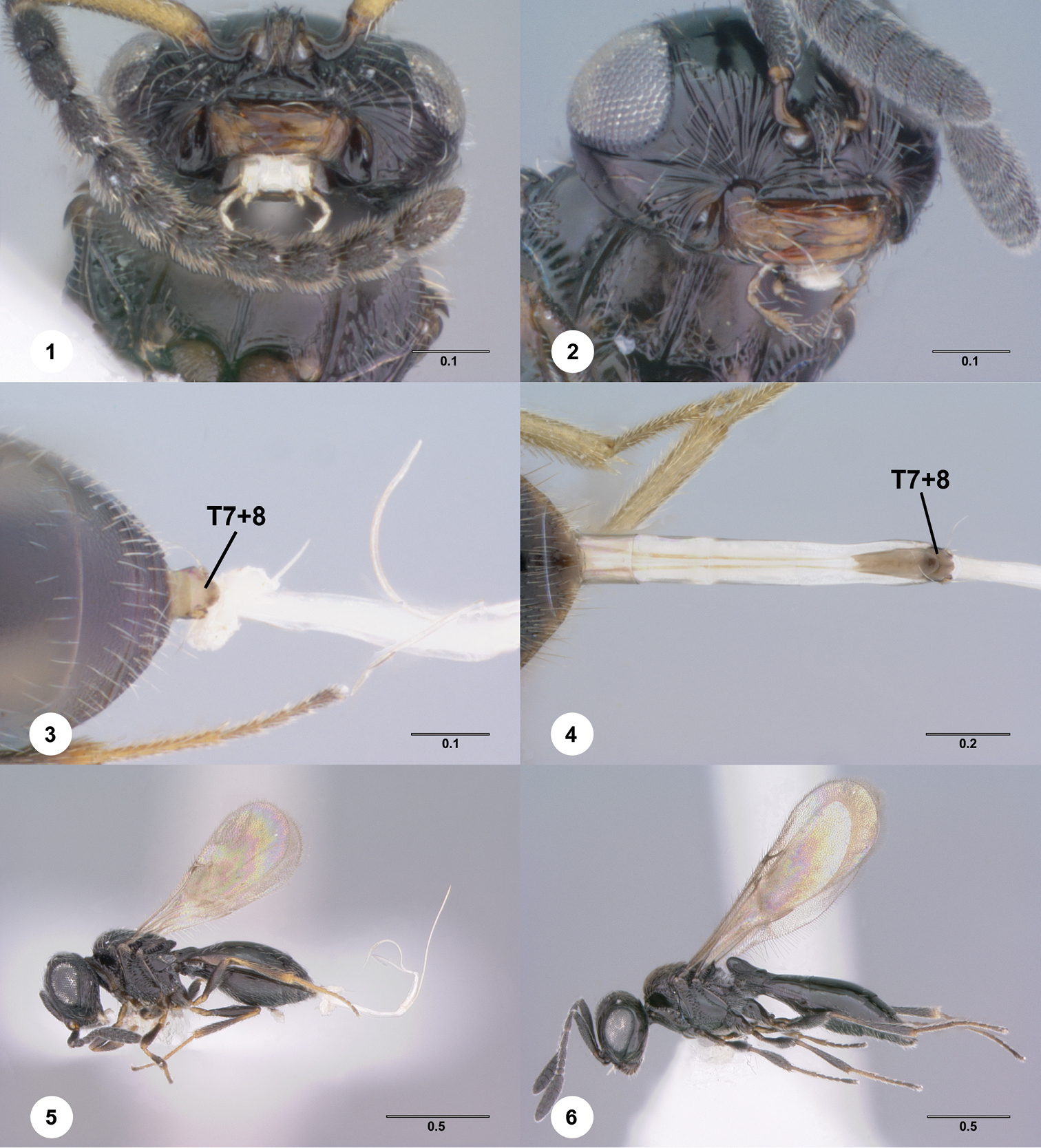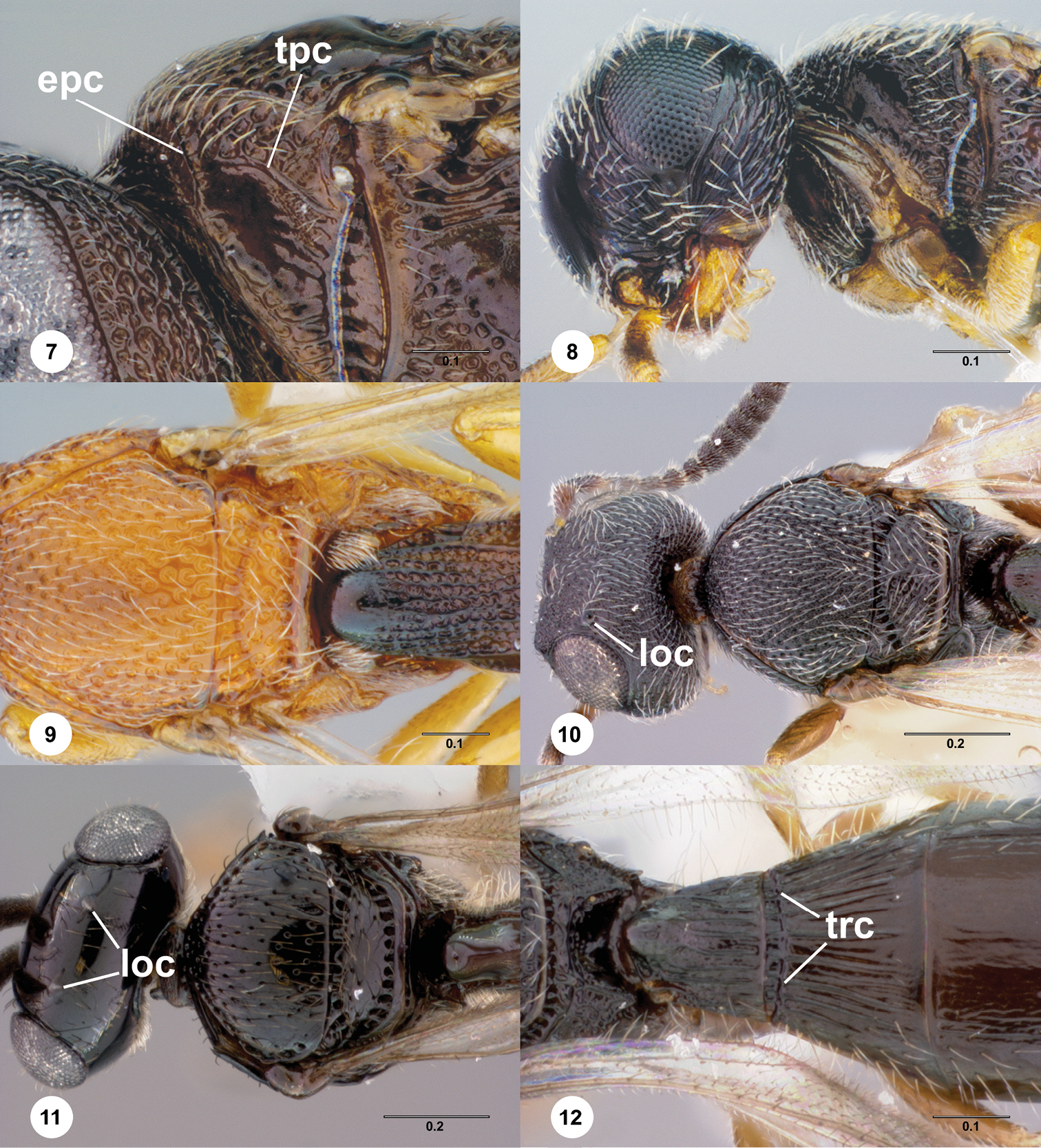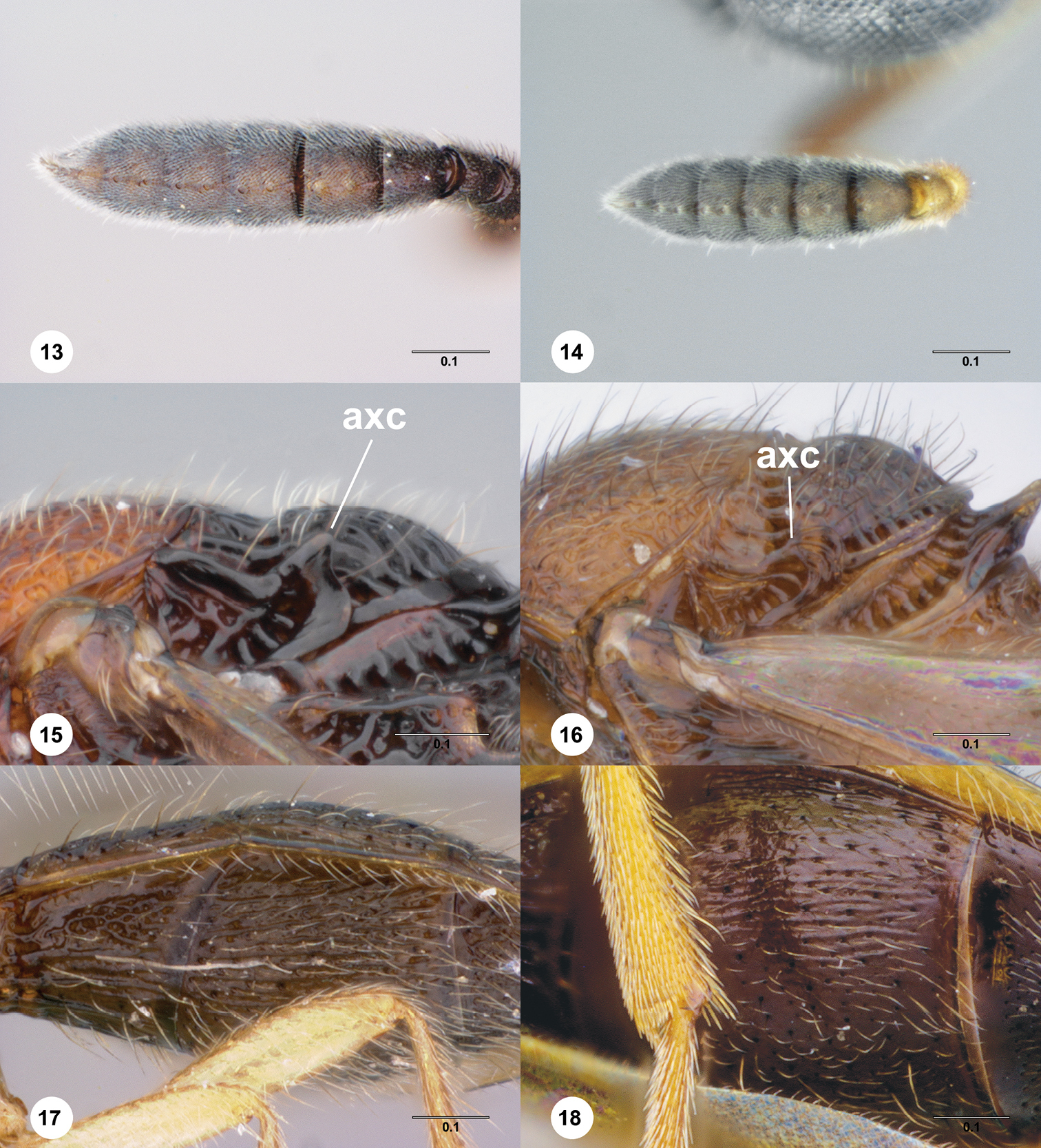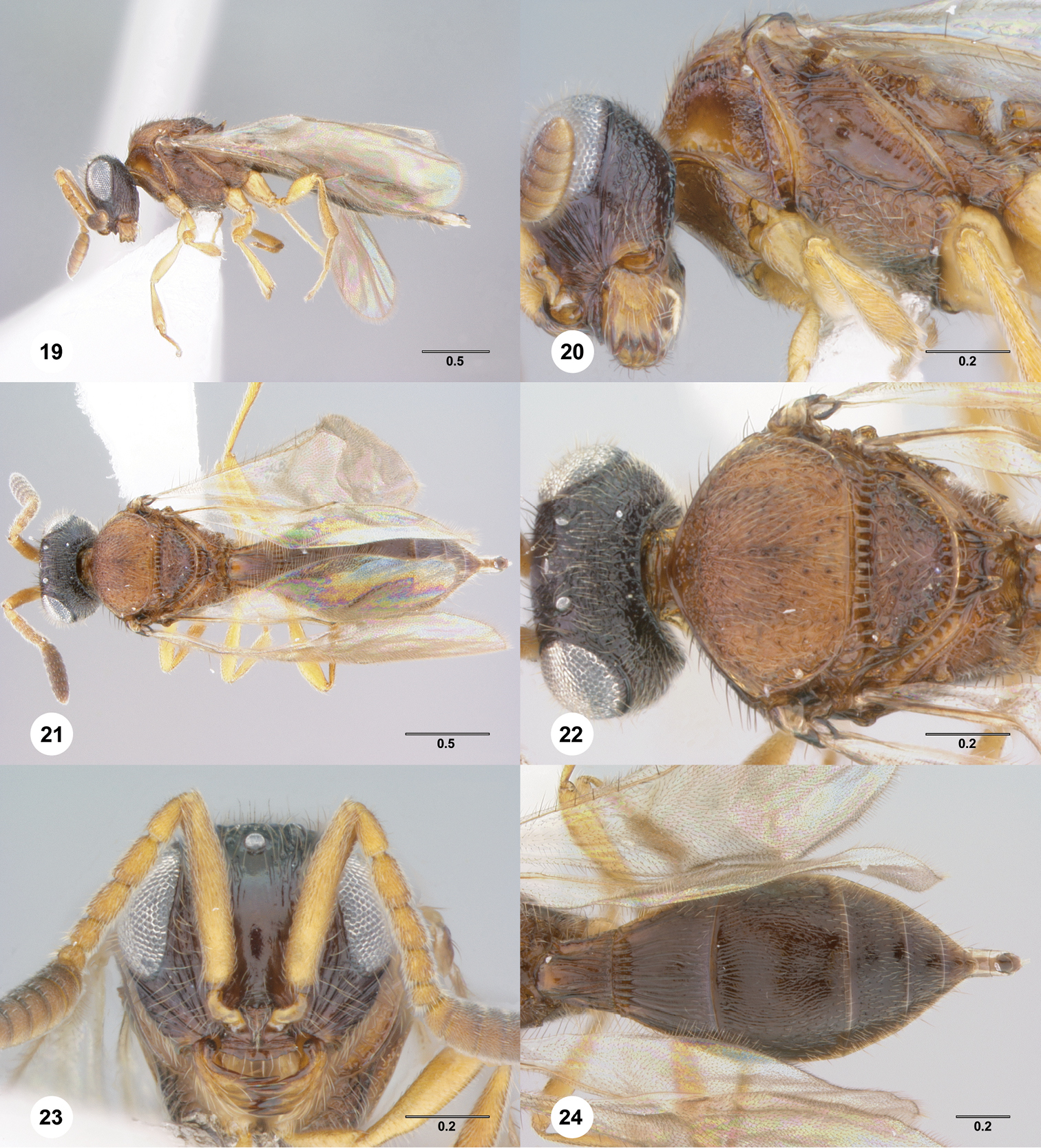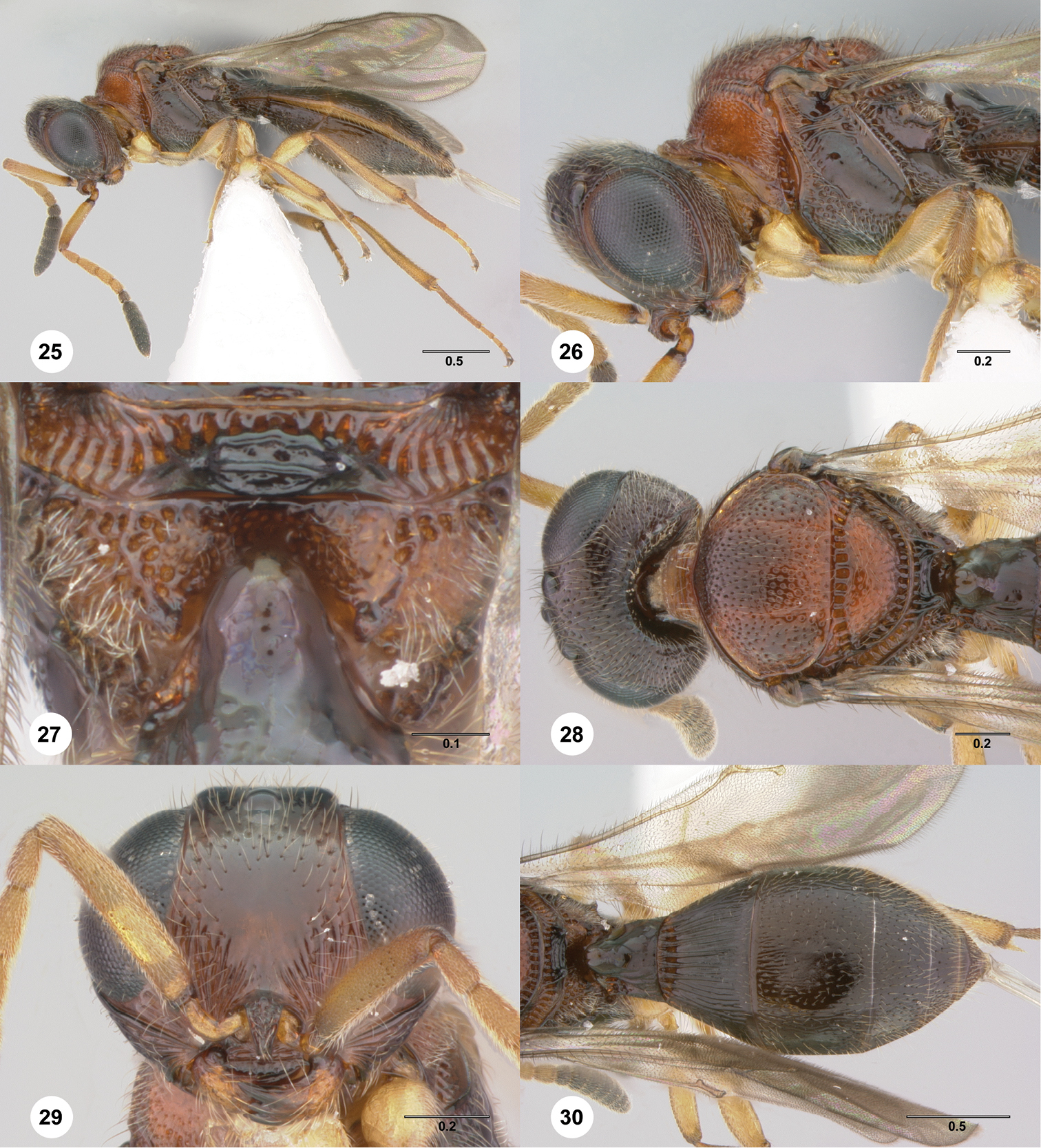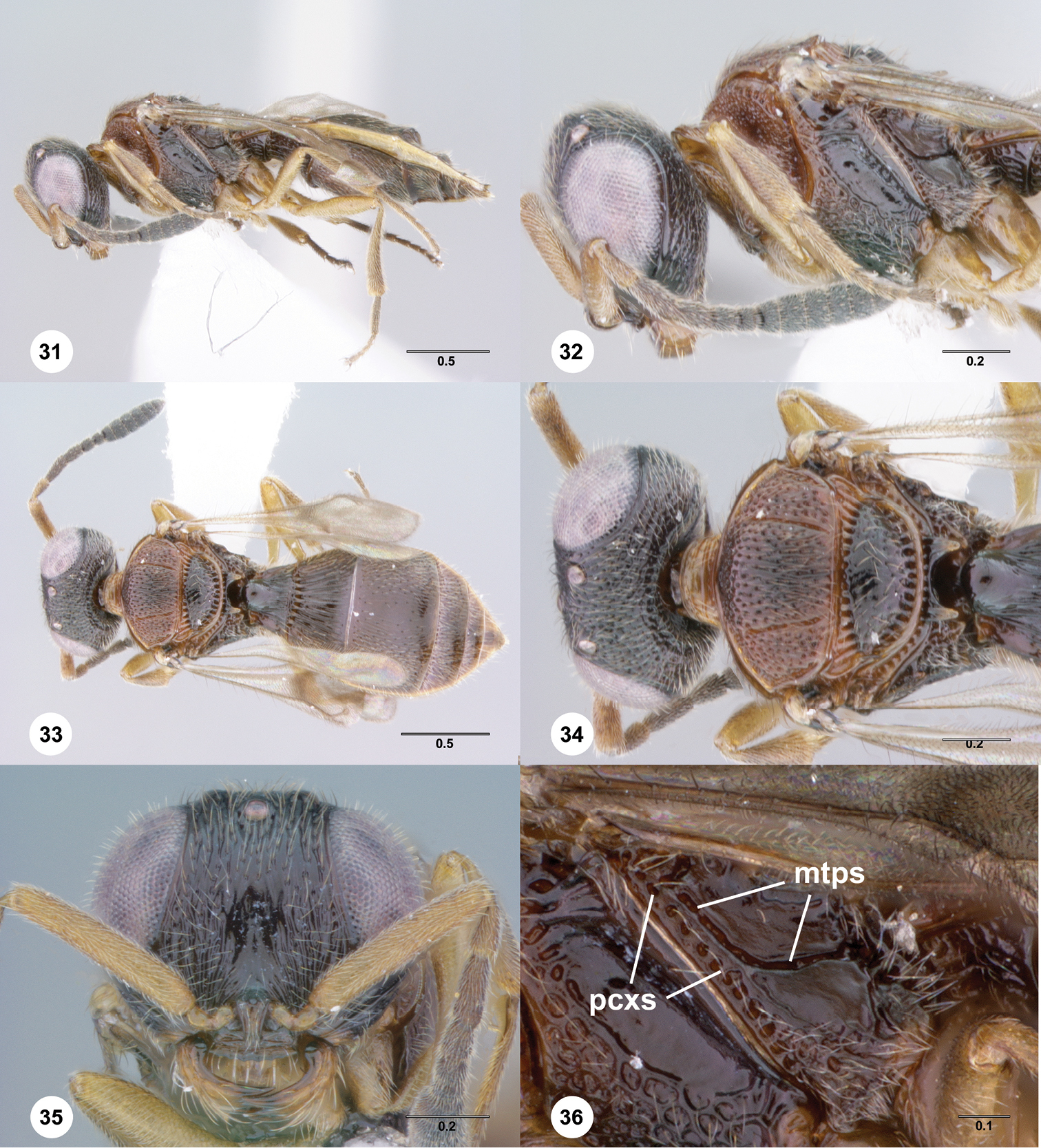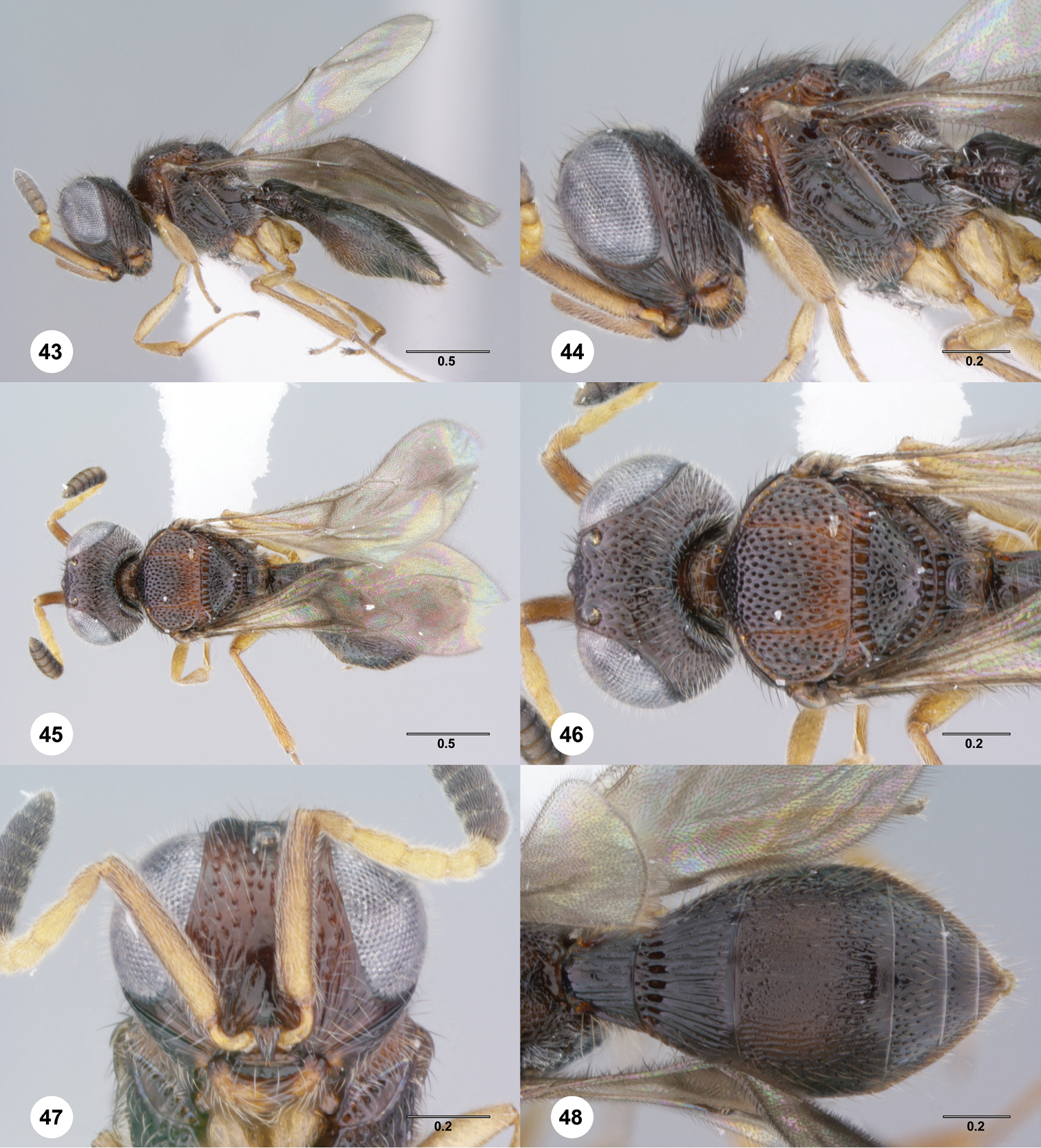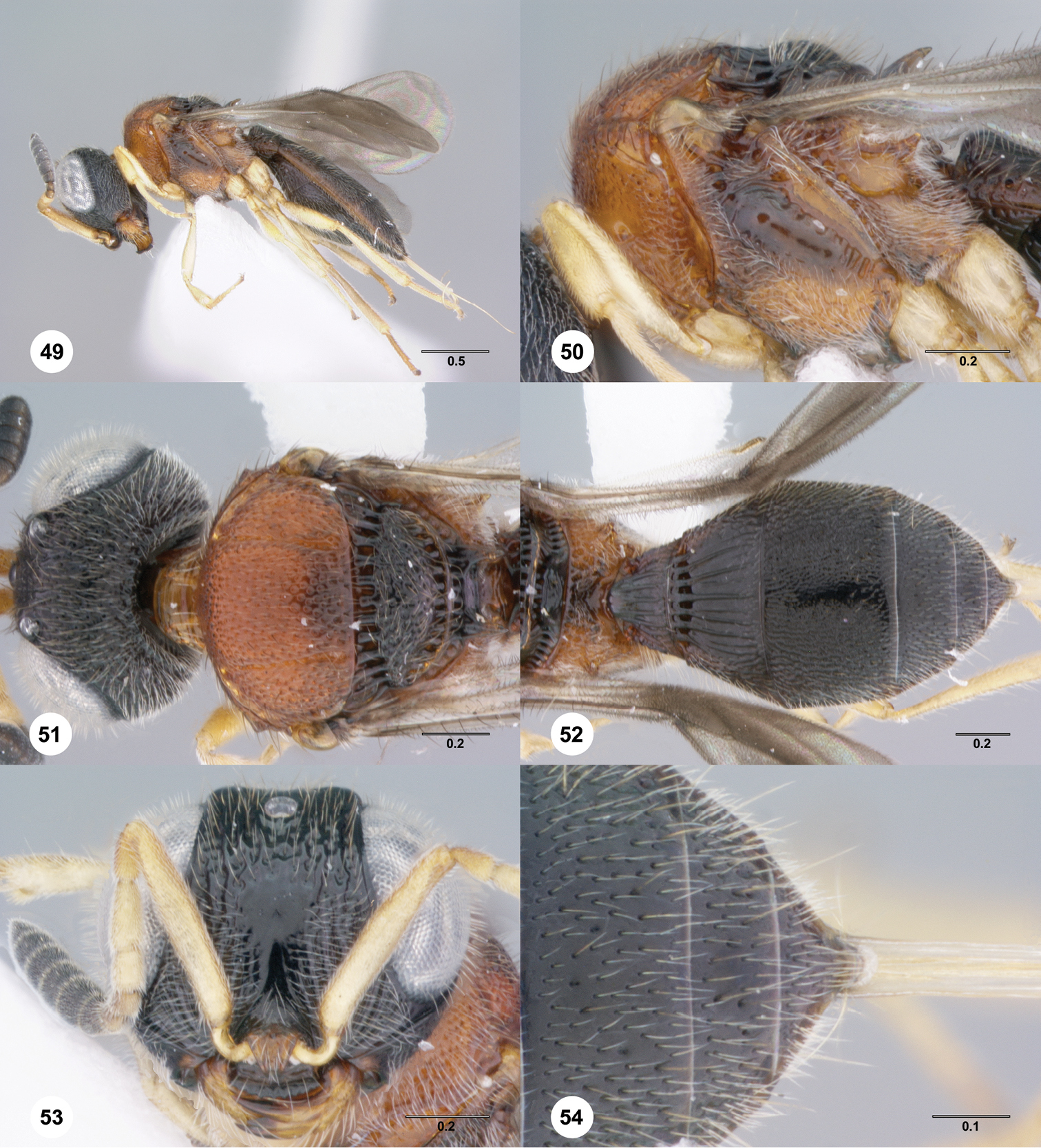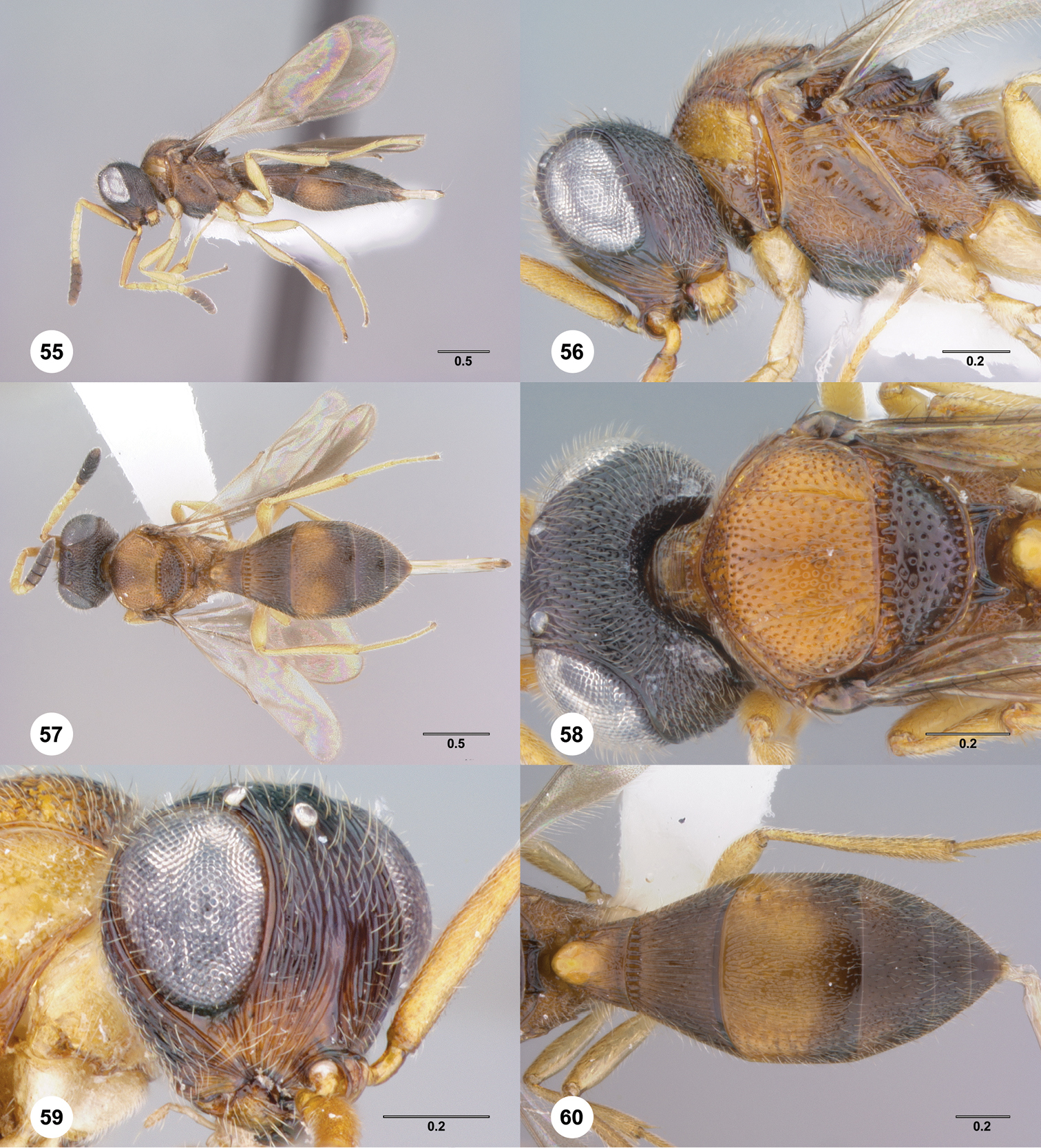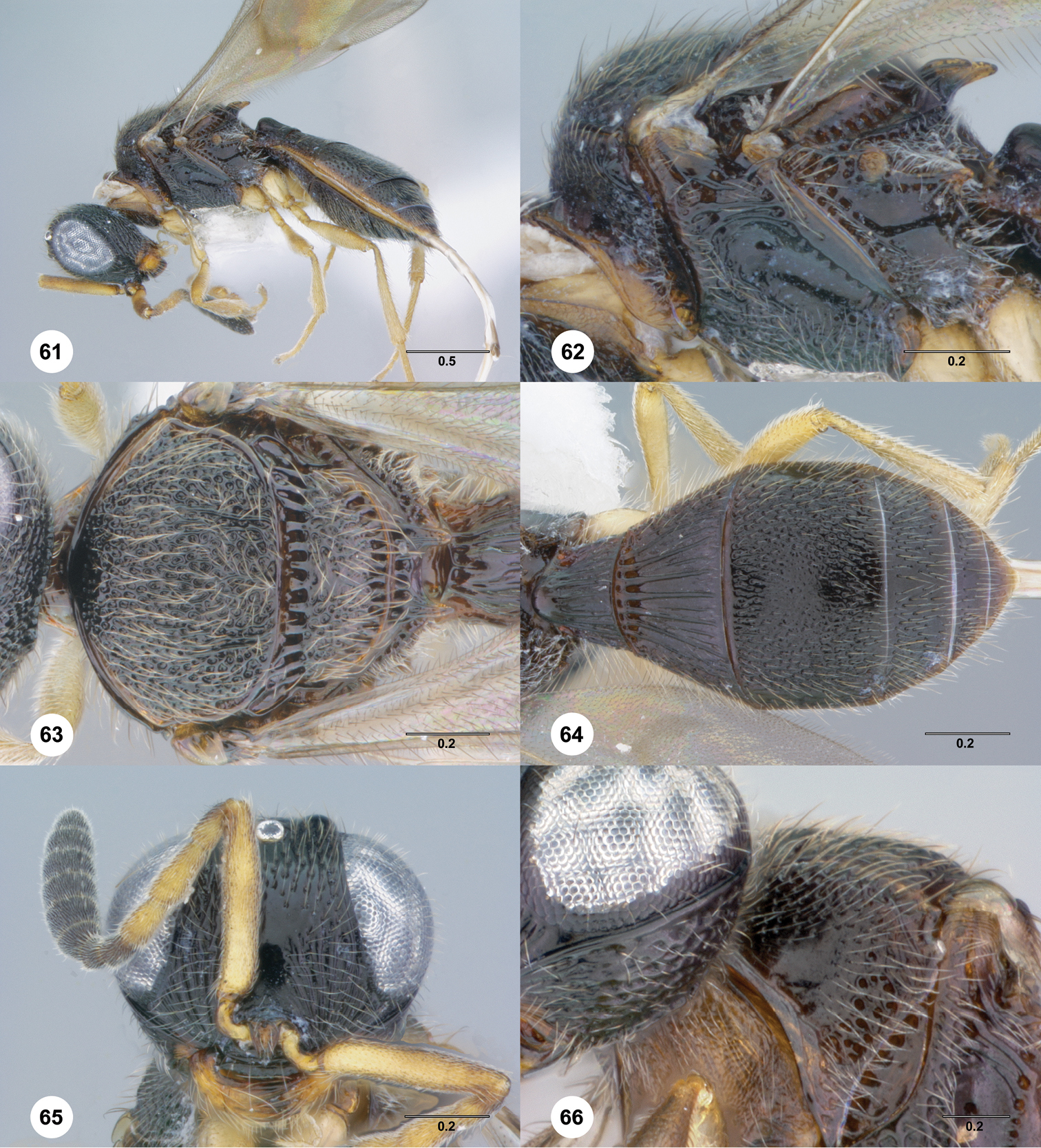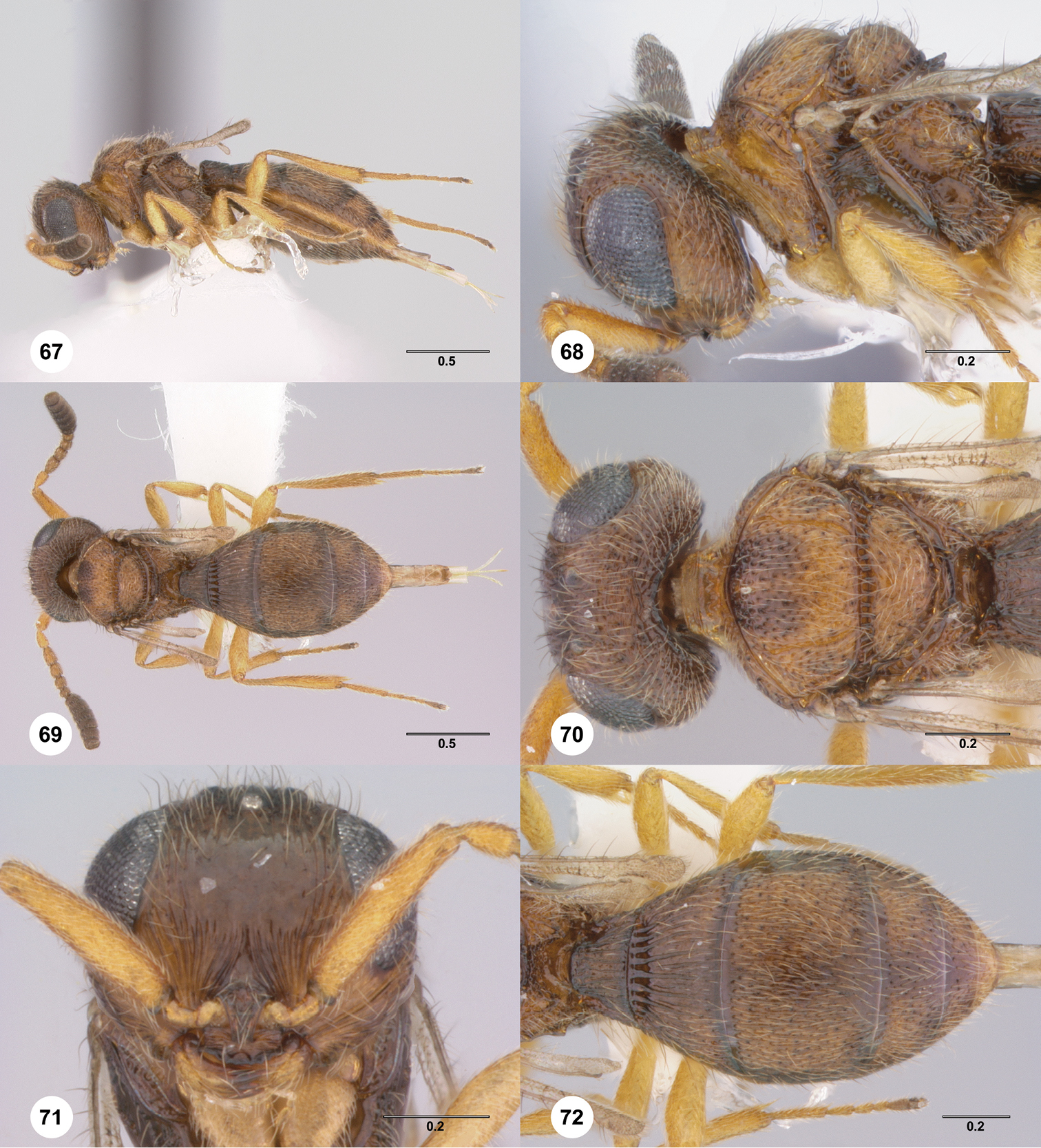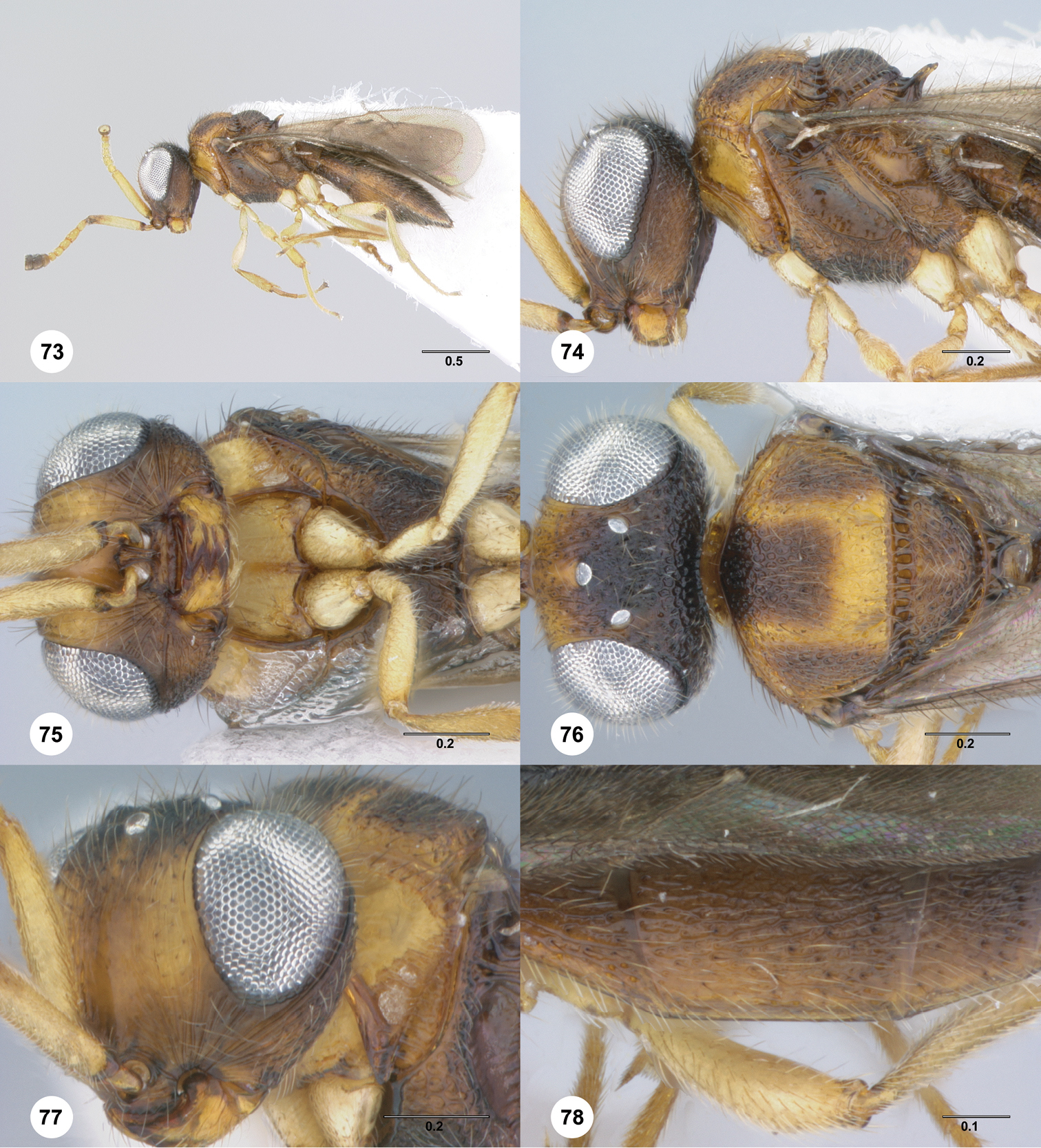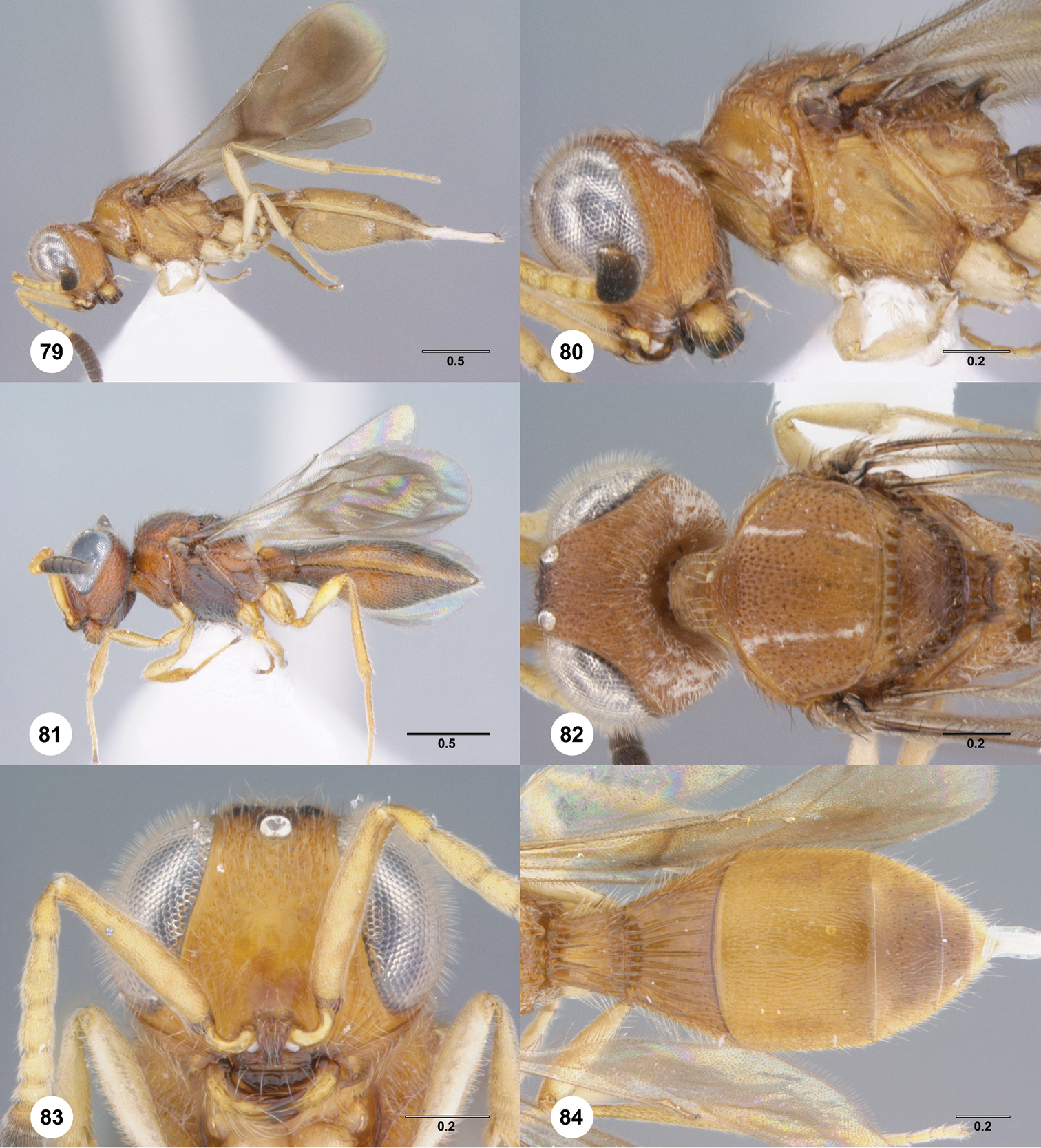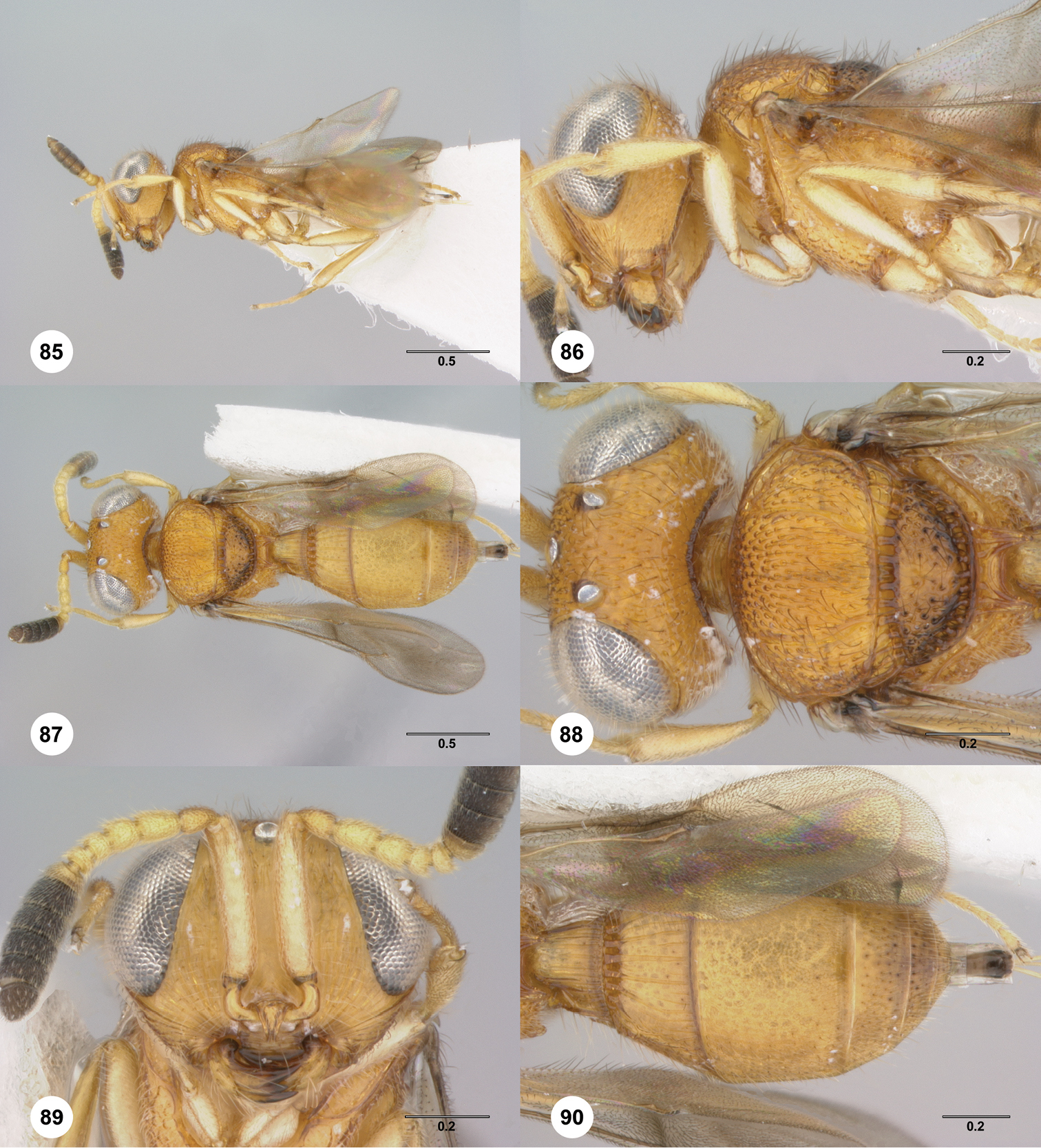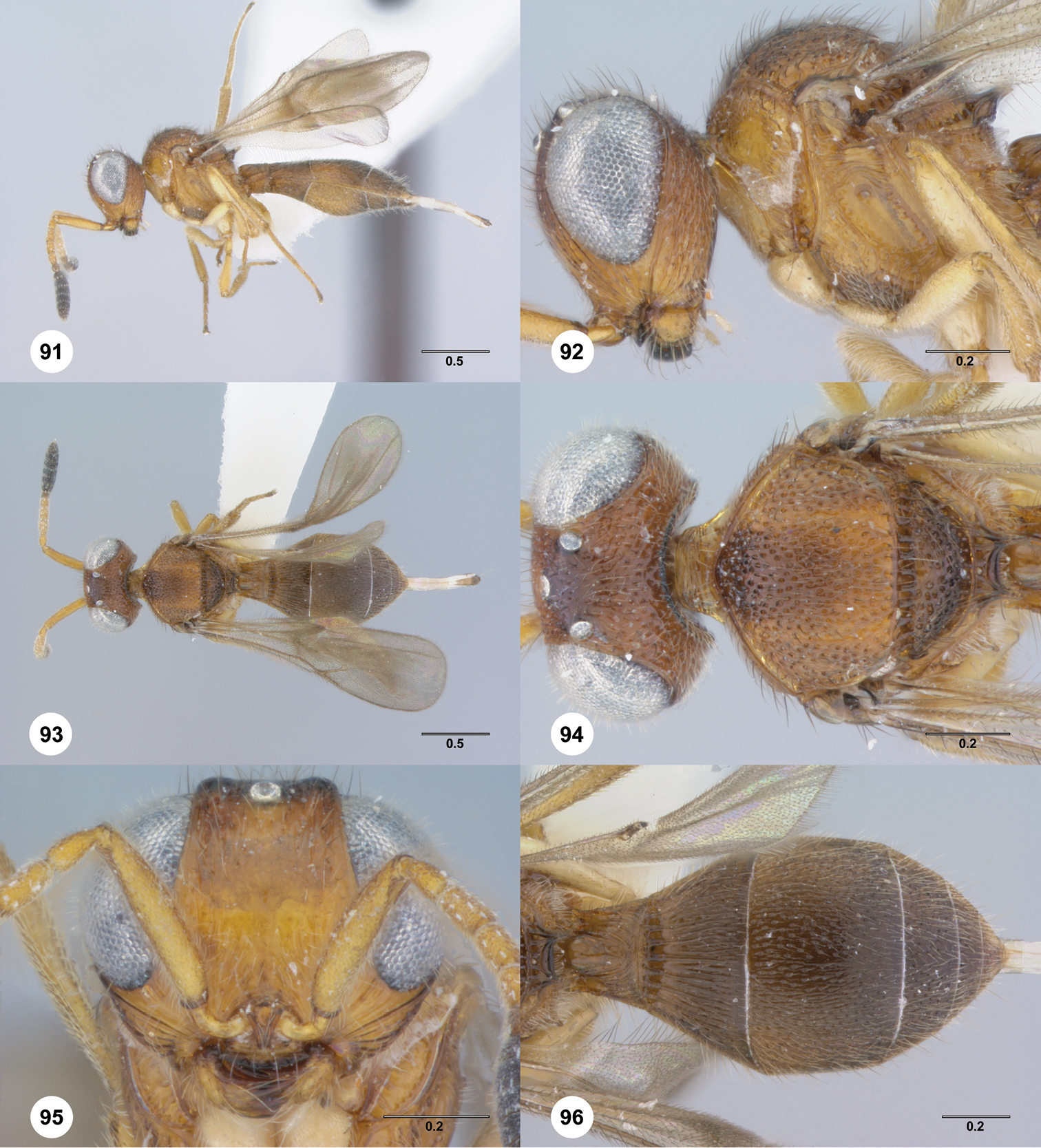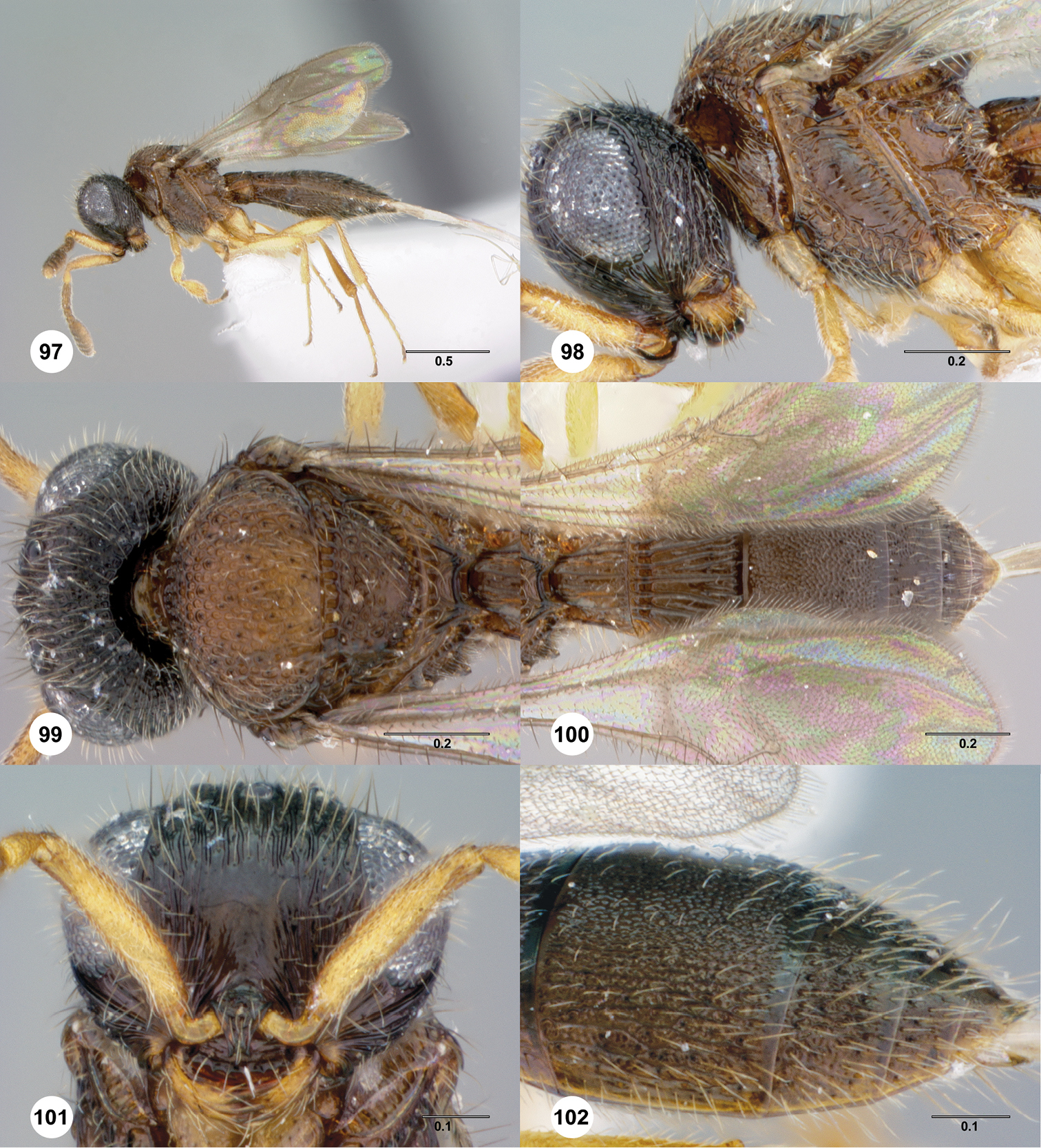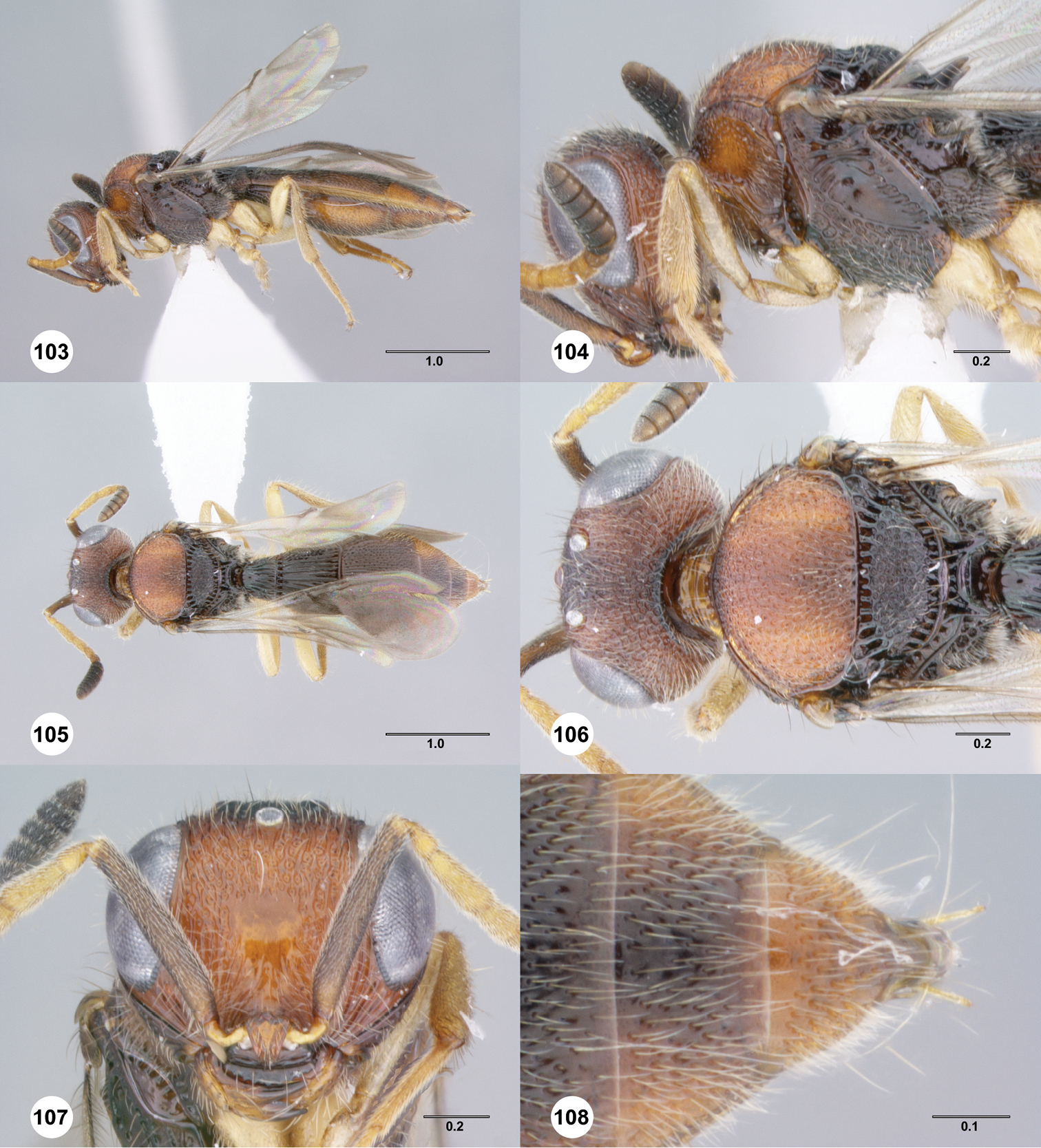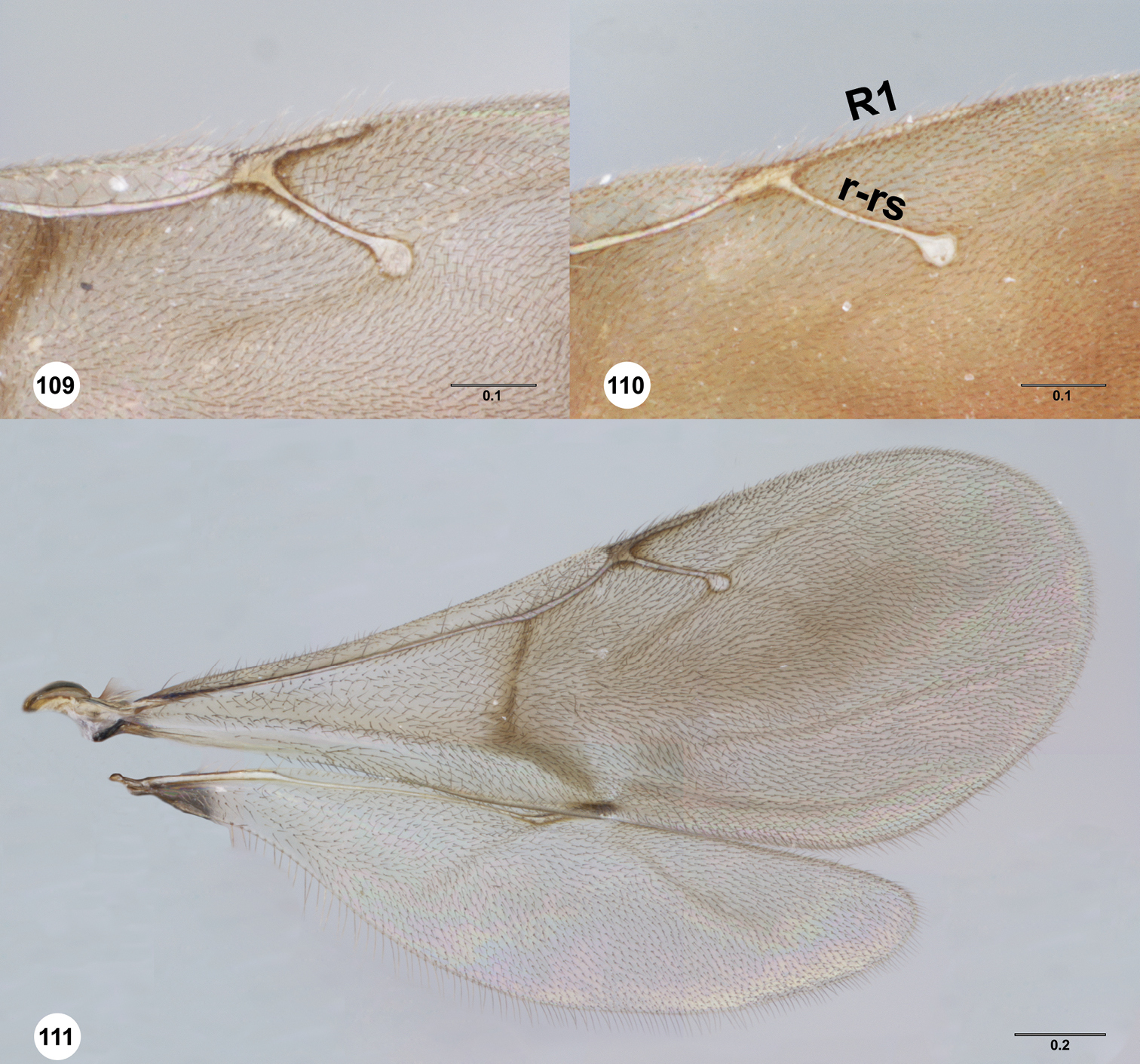






(C) 2011 Elijah J. Talamas. This is an open access article distributed under the terms of the Creative Commons Attribution License, which permits unrestricted use, distribution, and reproduction in any medium, provided the original author and source are credited.
For reference, use of the paginated PDF or printed version of this article is recommended.
The Paridris nephta group is revised (Hymenoptera: Platygastridae). Fifteen species are described, 14 of which are new: Paridris atroxTalamas, sp. n.(Yunnan Province, China), Paridris bununTalamas, sp. n.(Taiwan), Paridris ferusTalamas, sp. n.(Thailand), Paridris kagemonoTalamas, sp. n.(Japan), Paridris minatorTalamas, sp. n.(Laos, Thailand), Paridris mystaxTalamas, sp. n.(Laos, Thailand), Paridris nephta(Kozlov) (Japan, North Korea, South Korea, Far Eastern Russia), Paridris nilakaTalamas, sp. n.(Thailand), Paridris reptilisTalamas, sp. n.(Taiwan), Paridris rugulosusTalamas, sp. n.(Laos, Vietnam), Paridris solarisTalamas, sp. n.(Laos, Thailand, Vietnam), Paridris teresTalamas, sp. n.(Vietnam), Paridris toketokiTalamas, sp. n.(Taiwan), Paridris verrucosusTalamas, sp. n.(Guangdong Province, China), Paridris yakTalamas, sp. n.(Thailand).
Egg-parasitoid, Platygastroidea, key, species description, taxonomic revision
In 1978, M. Kozlov described a new genus of scelionine wasps based on material from the Russian Far East, with Tuora nephta Kozlov as its sole species. No major taxonomic changes occurred in this group until
The goals of this paper are to define the Paridris nephta group and describe its species. This work is conducted as part of the Platygastroidea Planetary Biodiversity Inventory and represents a step toward revision of Scelionini sensu lato and resolution of the relationships between its constituent genera. The contributions of the authors are as follows: E.J. Talamas: character definition, species group concept development, species concept development, imaging, key development, manuscript preparation; N.F. Johnson: species concept development, key development, manuscript preparation; L. Masner: species group concept development, manuscript preparation.
Materials and methodsSpecimens: This work is based upon specimens deposited in the following collections, with abbreviations used in the text: CNCI, Canadian National Collection of Insects, Ottawa, Canada1; IEBR, Institute of Ecology and Biolgical Resources, Hanoi, Vietnam2; IZCAS, Chinese Academy of Sciences, Institute of Zoology, Beijing, China3; OSUC, C.A. Triplehorn Insect Collection, Columbus, OH4; QSBG, Queen Sirikit Botanic Garden, Chiang Mai, Thailand5; ROME, Royal Ontario Museum, Ontario, Canada6; RMNH, Leiden Nationaal Natuurhistorische Museum, Netherlands7.
Morphology: Abbreviations and morphological terms used in text: A1, A2, ... A12: antennomere 1, 2, ... 12; claval formula: distribution of the multiporous basiconic sensilla on the underside of apical antennomeres of the female, with the antennomere interval specified followed by the number of sensilla per segment (
Axillular carina (axc: Figs 15–16)
Epomial carina (epc; Fig. 7)
Lateral ocellus (loc; Figs 10–11)
Metapleural sulcus (mtps; Fig. 36)
Paracoxal sulcus (pcxs; Fig. 36)
Transverse carina of T2 (trc; Fig. 12)
Transverse pronotal carina (tpc; Fig. 7)
Morphological terms used in this revision were matched to the Hymenoptera Anatomy Ontology (HAO,
The description of surface sculpture is presented in two formats. Areas of the exoskeleton in which the sculptural elements are inseparable are described simply as “sculpture”. For areas in which the sculptural elements vary independently, sculpture is divided into three categories: punctation: round depressions associated with setae; macrosculpture: raised or sunken patterns of texture that are oriented linearly or radially with respect to punctation or the axes of the body; microsculpture: unoriented, very fine wrinkles or pustulations that occur on, in, or between elements of macrosculpture and punctation.
Information Management: The locality data reported for primary types are not literal transcriptions of the labels: some abbreviations are expanded; additional data from the collectors are also included. The holotypes should be unambiguously identifiable by means of the unique identifier or the red holotype label. The numbers prefixed with “OSUC ” and “CASENT ” are unique identifiers for the individual specimens (note the blank space after the acronyms). Details on the data associated with these specimens may be accessed at the following link, purl.oclc.org/NET/hymenoptera/hol, and entering the identifier in the form. This monograph also features simultaneous publication and distribution of taxonomic and occurrence records through the Global Biodiversity Information Facility (GBIF) using DarwinCore Archives as in
Cybertools:The species descriptions are generated by a database application, vSysLab (purl.oclc.org/NET/hymenoptera/vSysLab), designed to facilitate the generation of taxon by character data matrices, to integrate these with the existing taxonomic and specimen-level database, and to export the data both as text and as input files for other applications. The output is in the format of “Character: Character state(s).”
Imaging: Images were produced using Combine ZP and AutoMontage extended-focus software. The individual images are archived at the image database at The Ohio State University (purl.oclc.org/NET/hymenoptera/specimage) and with MorphBank (www.morphbank.net). The latter also contains collections of images organized by plate.
Species Concept: For the purpose of this revision, species are defined as taxa diagnosable by putative autapomorphies or a unique combination of fixed character states.
Comments on Paridris KiefferThe genus Idris was described by Arnold Förster in 1856, and the name has been used as the root for a number of generic names in Platygastroidea.
The Nearctic Paridris brevipennis Fouts has one documented host association with Gryllus pennsylvanicus Burmeister (label data of a specimen in the USNM reported by
With the exception of
Previous authors have mentioned that Paridris may be confused with Probaryconus (Galloway and Austin 1984) and Anteris Förster (
Separation of Paridris from Probaryconus is a more complicated matter because both are polytypic. Probaryconus has neither notauli (Figs 9–10) nor an externally developed metascutellum (Figs 9–10), and always has spines, points, or dense tufts of setae on the propodeum (Figs 9–10). The epomial carina (Fig. 7) is present in Probaryconus (always absent in Paridris), with the exception of one widespread species group (Fig. 8) that also has setose eyes and a strongly reduced postmarginal vein. The transverse carina of T2 (Fig. 12) unambiguously identifies Paridris but is not present in all species (e.g. the Paridris nephta species group). In some Neotropical and Oceanic species of Paridris, the lateral propodeal carinae form two points lateral to the metasomal depression, similar to the propodeal points in Probaryconus Kieffer. The following key separates Probaryconus and Anteris from Paridris with the fewest characters possible.
Key to separate Paridris, Probaryconus and Anteris| 1 | Palpal formula 2-1 (Fig. 1); female T7+8, when extruded with ovipositor, connected to T6 by short, unsegmented conjunctiva (Fig. 3) | Anteris |
| – | Palpal formula 4-2 (Fig. 2); female T7+8, when extruded with ovipositor, connected to T6 by long, segmented conjunctiva (Fig. 4) | 2 |
| 2 | Metanotum visible medially and unaltered by horn of T1, or horn absent (Figs 10, 12) | 3 |
| – | Metanotum obscured medially by horn of T1 (Figs 9, 11) | 4 |
| 3 | Metascutellum visible externally, shape variable (Fig. 12) | Paridris |
| – | Metascutellum not visible externally (Fig. 10) | Probaryconus |
| 4 | Lateral ocellus remote from inner orbit, separated by distance of at least one ocellar diameter (Fig. 11) | Paridris |
| – | Lateral ocellus contiguous with inner orbit or separated by distance less than one ocellar diameter (Fig. 10) | Probaryconus |
The Paridris nephta species group can be separated from the remainder of Paridris by the combination of the following characters: occipital carina reaching base of mandible; mesoscutal suprahumeral sulcus absent mesal to notaulus; scutoscutellar and posterior scutellar sulci comprised of deep cells; metascutellum bispinose, glabrous; mesepisternum below femoral groove with coarse rugose sculpture; paracoxal and metapleural sulci not fused in dorsal half of metapleuron (Fig. 32); posterior margin of metapleuron with triangular point above metapleural sulcus; propodeum coarsely punctate rugose; plica indistinguishable or poorly distinguished from background sculpture of propodeum; anterior T2 without transverse carina; T6 evenly rounded, without dense microsculpture; felt field on S2 punctate, present throughout length of sternite.
Sexual dimorphism combined with the small number of males prevented us from associating males with females for all but two species, Paridris mystax and Paridris nephta. Consequently, only females are treated in the key and descriptions. Males for Paridris mystax and Paridris nephta have been entered as determined material, but not as paratypes for Paridris mystax. Four other male morphotypes have been imaged and can be found online at www.specimage.osu.edu and www.morphbank.net8, 9, 10, 11.
62 1 Anteris sp., head, mouthparts, ventral view, male (OSUC 241115)2 Paridris sp., head, mouthparts, anteroventral view, female (OSUC 190976)3 Anterissp., T5–T7, ovipositor, female (OSUC 261917)4 Paridris nilaka, T6–T7, ovipositor, female (OSUC 266165)5 Anterissp., lateral habitus, female (OSUC 261917)6 Paridrissp., lateral habitus, female (OSUC 191490). Scale bar in millimeters.
63 7Probaryconussp., pronotum, lateral view, female (OSUC 146809)8 Probaryconussp., head and pronotum, female (OSUC 58741)9 Probaryconussp., mesosoma and T1, dorsal view, female (OSUC 404933)10 Probaryconus rufipes (Kieffer), head and mesosoma, dorsal view, female (OSUC 396820)11 Paridrissp., head, mesosoma, T1, dorsal view, female (OSUC 262120)12 Paridrissp., metascutellum, propodeum, T1–T2, dorsal view, female (OSUC 265183). Scale bar in millimeters.
| 1 | Brachypterous, forewing not reaching apex of metasoma in repose (Figs 31, 33, 67, 69) | 2 |
| – | Macropterous, forewing extending beyond apex of metasoma in repose | 3 |
| 2 | A7 with basiconic sensillum (Fig. 14); sculpture of T3 reduced medially (Fig. 33); metapleural sulcus simple dorsally (Fig. 36) | Paridris ferus Talamas, sp. n. |
| – | A7 without basiconic sensillum (Fig. 13); sculpture of T3 not reduced medially (Fig. 72); metapleural sulcus foveolate dorsally (Fig. 68) | Paridris reptilis Talamas, sp. n. |
| 3 | Ventral clypeal margin edentate (Fig. 89); T3 covered in finely reticulate microsculpture (Fig. 90) | Paridris teresTalamas, sp. n. |
| – | Ventral clypeal margin serrate (Figs 53, 101, 107); sculpture of T3 variable | 4 |
| 4 | Ventral metapleural area entirely setose (Fig. 50); frons densely setose ventrolaterally (Fig. 53); head and metasoma black (Fig. 49) | Paridris mystax Talamas, sp. n. |
| – | Ventral metapleural area with glabrous area (Fig. 62); frons moderately to sparsely setose ventrolaterally (Fig. 107); body color variable | 5 |
| 5 | Notaulus absent or indicated only at posterior margin of mesoscutum (Figs 22, 106) | 6 |
| – | Notaulus present through posterior half of mesoscutum, usually reaching mesoscutal suprahumeral sulcus as smooth furrow or row of punctures (Figs 58, 76) | 8 |
| 6 | T1–T5, S3 with microsculpture throughout (Figs 17, 102); T3 evenly reticulate in medial third (Fig. 102) | Paridris verrucosus Talamas, sp. n. |
| – | Metasoma without microsculpture (Figs 18, 105); T3 longitudinally strigose (Figs 12, 105) | 7 |
| 7 | Frons immediately below median ocellus smooth (Fig. 23); axillular carina rounded dorsally (Fig. 16); S3 with longitudinal striae (Fig. 18) | Paridris atrox Talamas, sp. n. |
| – | Frons immediately below median ocellus rugose, with setigerous foveae (Fig. 107); axillular carina pointed dorsally (Fig. 15); S3 without longitudinal striae | Paridris yakTalamas, sp. n. |
| 8 | A7 with basiconic sensillum (Fig. 14) | 9 |
| – | A7 without basiconic sensillum (Fig. 13) | 10 |
| 9 | R1 (postmarginal vein) distinctly shorter than r-rs (stigmal vein) (Fig. 109); T3 smooth with weakly impressed longitudinal striae laterally (Fig. 30), microsculpture absent; punctation of head fine (Fig. 29) | Paridris bunun Talamas, sp. n. |
| – | R1 (postmarginal vein) about as long as r-rs (stigmal vein) (Fig. 111); T3 with prominent longitudinal strigae laterally, often strigose throughout, microsculpture usually present (Fig. 48); punctation of head variable, often coarse (Fig. 47) | Paridris minator Talamas, sp. n. |
| 10 | Mesoscutellum punctate, interspaces between punctures smooth and usually broad (Figs. 58, 82) | 11 |
| – | Mesoscutellum rugulose to areolate (Figs 40, 63, 76, 94) | 12 |
| 11 | Frons evenly striate throughout, striae directly above interantennal process sometimes effaced (Fig. 59); interstitial punctation on frons very fine (Fig. 59) | Paridris nephta (Kozlov) |
| – | Frons directly below median ocellus coarsely strigose to rugose; frons always with smooth area above interantennal process; interstitial punctation on frons coarse (Fig. 83) | Paridris solaris Talamas, sp. n. |
| 12 | Frons evenly striate throughout, with microsculpture present interstitially (Fig. 41) | Paridris kagemono Talamas, sp. n. |
| – | Striae of frons, if present, not uniform throughout, microsculpture absent (Figs 65, 77, 95) | 13 |
| 13 | Pronotum with uniform, fine, white setae along transverse pronotal carina (Fig. 66); body dark brown to black (Fig. 61) | Paridris nilaka Talamas, sp. n. |
| – | Pronotum with dark, bristlelike setae along transverse pronotal carina (Figs 77, 94); body color variable | 14 |
| 14 | Pronotum below transverse pronotal carina mostly smooth, with sparse rugulae (Fig. 77) | Paridris rugulosus Talamas, sp. n. |
| – | Pronotum below transverse pronotal carina densely punctate (as in Fig. 66) | Paridris toketoki Talamas, sp. n. |
urn:lsid:zoobank.org:pub:BCD3BD6E-5E29-447F-AEB6-176C19EEF3E8
urn:lsid:biosci.ohio-state.edu:osuc_concepts:275737
http://species-id.net/wiki/Paridris_atrox
Figures 16, 19–24; Morphbank 12Description. Female body length: 2.73 mm (n=1). Color of head: reddish brown. Ventral clypeal margin: serrate. Sculpture of frons medially: smooth. Sculpture of frons immediately ventral of median ocellus: dorsoventrally strigose laterally. Microsculpture of frons: absent. Sculpture of posterior vertex: irregularly rugulose. Sculpture of gena: irregularly rugulose. Basiconic sensillum on A7: absent.
Wings: macropterous, apex of forewing extending beyond posterior margin of T3. Length of R1: equal to r-rs. Notaulus: absent. Color of mesosoma: variably orange to brown. Sculpture of mesoscutum medially: areolate rugulose. Sculpture of mesoscutellum: areolate rugulose. Dark bristlelike setae along transverse pronotal carina: present. Sculpture ventral of transverse pronotal carina: rugulose posteriorly. Sculpture of femoral groove: striate below mesopleural pit. Sculpture of ventral half of posterior mesepimeral area: rugulose. Fine setigerous punctures on dorsal half of posterior mesepimeral area: absent. Mesopleural carina: present. Setation of ventral metapleural area: absent in area immediately below metapleural sulcus. Setation of metapleural triangle: moderately dense. Color of legs: yellow throughout.
Color of metasoma: reddish brown. Horn of T1: bulge smooth, at least anteriorly. Microsculpture of T2: absent. Microsculpture on T3: absent. Macrosculpture of T3 medially: weakly longitudinally strigose. Macrosculpture of T3 laterally: longitudinally strigose. Microsculpture of T4: absent. Macrosculpture of T4 laterally: weakly rugulose. Punctation of T4: moderately dense throughout. Macrosculpture of T5: absent. Punctation of T5: moderately dense throughout. Microsculpture of S3: absent. Macrosculpture of S3 laterally: weakly longitudinally strigose.
64 13 Paridris nilaka, sp. n., antennal clava, ventral view, female (OSUC 334247)14 Paridris minator, sp. n., antennal clava, ventral view, female holotype (OSUC 237531)15 Paridris yak, sp. n, scuto-axillar complex, lateral view, female holotype (OSUC 237530)16 Paridris atrox, sp. n., scuto-axillar complex, lateral view, female holotype (OSUC 241473)17 Paridris verrucosus, sp. n., S2–S3, ventrolateral view, female holotype (OSUC 334249)18 Paridris atrox, sp. n., S3, ventrolateral view, female holotype (OSUC 241473). Scale bars in millimeters.
65Paridris atrox sp. n., female holotype (OSUC 241473) 19 Lateral habitus20 Head and mesosoma, lateral view21 Dorsal habitus22 Head and mesosoma, dorsal view23 Head, anterior view24 Metasoma, dorsal view. Scale bars in millimeters.
Paridris atrox may be separated from the other members of the Paridris nephta species group by the absence of notauli and the presence of striation on S3.
Paridris atrox is named for the severe appearance of its head, its mandibles in particular. The specific epithet is adjectival, and means “fearsome” in Latin.
13
Holotype, female: CHINA: Yunnan Prov., Baoshan City, 28 km (air)SE Tengyue (Teng Chong), pass over Gaoligong Mts., clearing / natural forest, Luoshuidong, 24°57'N, 98°45'E, 2300m, 26.X–31.X.1998, flight intercept trap, C. Griswold, D. Kavanaugh & C. L. Long, OSUC 241473 (deposited in IZCAS).
urn:lsid:zoobank.org:act:A3CA8ADB-0B8F-47C1-A757-9CEAE44779A2
urn:lsid:biosci.ohio-state.edu:osuc_concepts:273886
http://species-id.net/wiki/Paridris_bunun
Figures 25–30; Morphbank 14Female body length: 3.41 mm (n=1). Color of head: dark red, becoming darker dorsally. Ventral clypeal margin: serrate. Sculpture of frons medially: smooth. Sculpture of frons immediately ventral of median ocellus: dorsoventrally strigose laterally. Microsculpture of frons: absent. Sculpture of posterior vertex: finely punctate. Sculpture of gena: densely and finely punctate. Basiconic sensillum on A7: present.
Wings: macropterous, apex of forewing extending beyond posterior margin of T3. Length of R1: less than r-rs. Notaulus: present in posterior half of mesoscutum. Color of mesosoma: variably red to black. Sculpture of mesoscutum medially: densely punctate throughout. Sculpture of mesoscutellum: densely punctate. Dark bristlelike setae along transverse pronotal carina: absent. Sculpture ventral of transverse pronotal carina: finely punctate. Sculpture of femoral groove: smooth. Sculpture of ventral half of posterior mesepimeral area: smooth. Fine setigerous punctures on dorsal half of posterior mesepimeral area: present. Mesopleural carina: present along anterior half of femoral groove. Setation of ventral metapleural area: absent in area immediately below metapleural sulcus. Setation of metapleural triangle: moderately dense. Color of legs: yellow throughout.
Color of metasoma: reddish brown. Horn of T1: bulge smooth, at least anteriorly. Microsculpture of T2: absent. Microsculpture on T3: absent. Macrosculpture of T3 medially: absent. Macrosculpture of T3 laterally: weakly longitudinally strigose. Microsculpture of T4: absent. Macrosculpture of T4 laterally: weakly longitudinally strigose. Punctation of T4: sparse in medial third, moderately dense laterally. Macrosculpture of T5: absent. Punctation of T5: absent in medial third, moderately dense laterally. Microsculpture of S3: absent. Macrosculpture of S3 laterally: absent.
66Paridris bunun sp. n., female holotype (OSUC 262237) 25 Lateral habitus26 Head and mesosoma, lateral view27 Propodeum, posterodorsal view28 Head and mesosoma, dorsal view29 Head, anterior view30 Metasoma, dorsal view. Scale bars in millimeters.
Paridris bunun is most similar to Paridris minator, though the two have widely disjunct distributions, Taiwan and Southeast Asia, respectively. The two may be separated by the medially smooth T3 and short R1 (postmarginal vein) of Paridris bunun and the longer setation of the body in Paridris minator. Paridris bunun is a much larger species than Paridris minator, but it is known from a single specimen and thus we are not able to assess its size variation. Some species of the Paridris nephta group are known to exhibit significant size variation (e.g. Paridris nilaka) and thus size should be used cautiously.
The species is named for the Bunun tribe of Taiwan that historically occupied the region where it was collected. The name is treated as a noun in apposition.
15
Holotype, female: TAIWAN: Taiwan Prov., Pingtung Co., T’eng-chih (Tengchi) Medium-Altitude Experiment Station, 23°05.75'N, 120°47.37'E , 1660m, 3.VI–5.VI.2008, yellow pan trap, L. Masner, OSUC 262237 (deposited in CNCI).
urn:lsid:zoobank.org:act:6B7296C1-4E71-4A35-B937-ABB1949B7DBE
urn:lsid:biosci.ohio-state.edu:osuc_concepts:241281
http://species-id.net/wiki/Paridris_ferus
Figures 31–36; Morphbank 16Description. Female body length: 2.89 mm (n=1). Color of head: black throughout. Ventral clypeal margin: serrate. Sculpture of frons medially: smooth. Sculpture of frons immediately ventral of median ocellus: dorsoventrally striate throughout. Microsculpture of frons: absent. Sculpture of posterior vertex: punctate rugulose. Sculpture of gena: dorsoventrally strigose. Basiconic sensillum on A7: present.
Wings: brachypterous, apex of forewing ending before T4. Notaulus: percurrent. Color of mesosoma: variably orange to brown. Sculpture of mesoscutum medially: densely punctate, with longitudinal rugae in posterior half. Sculpture of mesoscutellum: smooth along midline, otherwise punctate rugulose. Dark bristlelike setae along transverse pronotal carina: absent. Sculpture ventral of transverse pronotal carina: finely punctate. Sculpture of femoral groove: striate in ventral end. Sculpture of ventral half of posterior mesepimeral area: smooth. Fine setigerous punctures on dorsal half of posterior mesepimeral area: present. Mesopleural carina: present along anterior half of femoral groove. Setation of ventral metapleural area: absent in area immediately below metapleural sulcus. Setation of metapleural triangle: dense. Color of legs: pale brown throughout.
Color of metasoma: orange to brown. Horn of T1: bulge smooth, at least anteriorly. Microsculpture of T2: absent. Microsculpture on T3: absent. Macrosculpture of T3 medially: absent. Macrosculpture of T3 laterally: longitudinally strigose. Microsculpture of T4: absent. Macrosculpture of T4 laterally: absent. Punctation of T4: moderately dense throughout. Macrosculpture of T5: absent. Punctation of T5: moderately dense throughout. Microsculpture of S3: absent. Macrosculpture of S3 laterally: longitudinally strigose.
67Paridris ferus sp. n., female holotype (OSUC 192426) 31 Lateral habitus32 Head and mesosoma, lateral view33 Dorsal habitus34 Head and mesosoma, dorsal view35 Head, anterior view36 Metapleuron, lateral view. Scale bars in millimeters.
Paridris ferus and Paridris reptilis are the only brachypterous species known in the Paridris nephta group. Aside from this character, these two species are not particularly similar and may be separated by the presence of a basiconic sensillum on A7, the smooth form of the metapleural sulcus and longitudinal striation of S3 in Paridris ferus.
The adjectival epithet “ferus” means “wild” or “untamed” in Latin and refers to the “savage” appearance of this species.
17
Holotype, female: THAILAND: Chiang Mai Prov., summit forest, T178, Doi Inthanon National Park, 18°35.361'N, 98°29.157'E , 2500m, 9.VIII–16.VIII.2006, malaise trap, Y. Areeluck, OSUC 192426 (deposited in QSBG).
urn:lsid:zoobank.org:act:59410F97-5DD7-4E7E-A7C3-2F25DD7665AE
urn:lsid:biosci.ohio-state.edu:osuc_concepts:273916
http://species-id.net/wiki/Paridris_kagemono
Figures 37–42; Morphbank 18Description. Female body length: 2.65 mm (n=1). Color of head: dark orange, becoming brown at vertex. Ventral clypeal margin: serrate. Sculpture of frons medially: dorsoventrally striate. Sculpture of frons immediately ventral of median ocellus: dorsoventrally striate throughout. Microsculpture of frons: present. Sculpture of posterior vertex: punctate rugulose. Sculpture of gena: irregularly rugulose. Basiconic sensillum on A7: absent.
Wings: macropterous, apex of forewing extending beyond posterior margin of T3. Length of R1: less than r-rs. Notaulus: percurrent. Color of mesosoma: orange throughout. Sculpture of mesoscutum medially: densely punctate throughout. Sculpture of mesoscutellum: punctate rugulose throughout. Dark bristlelike setae along transverse pronotal carina: absent. Sculpture ventral of transverse pronotal carina: punctate rugulose. Sculpture of femoral groove: striate below mesopleural pit. Sculpture of ventral half of posterior mesepimeral area: smooth. Fine setigerous punctures on dorsal half of posterior mesepimeral area: present. Mesopleural carina: absent. Setation of ventral metapleural area: absent in area immediately below metapleural sulcus. Setation of metapleural triangle: moderately dense. Color of legs: yellow throughout.
Color of metasoma: orange throughout. Horn of T1: absent. Microsculpture of T2: present. Microsculpture on T3: present. Macrosculpture of T3 medially: reticulate rugose. Macrosculpture of T3 laterally: reticulate rugose. Microsculpture of T4: absent. Macrosculpture of T4 laterally: weakly rugulose. Punctation of T4: moderately dense throughout. Macrosculpture of T5: absent. Punctation of T5: moderately dense throughout. Microsculpture of S3: absent. Macrosculpture of S3 laterally: absent.
68Paridris kagemono sp. n., female holotype (OSUC 262193) 37 Lateral habitus38 Mesosoma, lateral view39 Forewing, dorsal view40 Head and mesosoma, dorsal view41 Head, anterior view42 Metasoma, dorsal view. Scale bars in millimeters.
Paridris kagemono is most similar to Paridris nephta. It may be separated from it, and all other members of the Paridris nephta species group, by the presence of microsculpture between the striae of the frons.
The epithet “kagemono” means “supernatural creature of the night” in Japanese. It is used as a noun in apposition.
19
Holotype, female: JAPAN: Fukuoka Pref., Kyushu Isl., primary evergreen forest, Mount Tachibana, 1.VII–6.VII.1979, yellow pan trap, K. Yamagishi, OSUC 262193 (deposited in CNCI).
urn:lsid:zoobank.org:act:6A07840D-7470-4B42-89E2-7012B99C6C8F
urn:lsid:biosci.ohio-state.edu:osuc_concepts:241284
http://species-id.net/wiki/Paridris_minator
Figures 14, 43–48; Morphbank 20Description. Female body length: 2.27–2.53 mm (n=9). Color of head: uncertain, reddish brown. Ventral clypeal margin: serrate. Sculpture of frons medially: smooth. Sculpture of frons immediately ventral of median ocellus: dorsoventrally strigose throughout; rugose. Microsculpture of frons: absent. Sculpture of posterior vertex: finely punctate; punctate rugulose. Sculpture of gena: punctate rugulose; densely and finely punctate. Basiconic sensillum on A7: present.
Wings: macropterous, apex of forewing extending beyond posterior margin of T3. Length of R1: equal to r-rs; longer than r-rs. Notaulus: percurrent. Color of mesosoma: variably red to black. Sculpture of mesoscutum medially: densely punctate throughout. Sculpture of mesoscutellum: densely punctate. Dark bristlelike setae along transverse pronotal carina: absent. Sculpture ventral of transverse pronotal carina: finely punctate. Sculpture of femoral groove: smooth. Sculpture of ventral half of posterior mesepimeral area: smooth. Fine setigerous punctures on dorsal half of posterior mesepimeral area: present. Mesopleural carina: present. Setation of ventral metapleural area: absent in area immediately below metapleural sulcus. Setation of metapleural triangle: moderately dense. Color of legs: pale brown throughout; yellow throughout.
Color of metasoma: dark brown to black throughout; reddish brown. Horn of T1: bulge smooth, at least anteriorly. Microsculpture of T2: absent. Microsculpture on T3: present. Macrosculpture of T3 medially: reticulate; longitudinally strigose; weakly longitudinally strigose. Macrosculpture of T3 laterally: longitudinally strigose. Microsculpture of T4: absent. Macrosculpture of T4 laterally: weakly rugulose; absent. Punctation of T4: moderately dense throughout. Macrosculpture of T5: absent. Punctation of T5: moderately dense throughout. Microsculpture of S3: absent. Macrosculpture of S3 laterally: absent.
69Paridris minator sp. n., female holotype (OSUC 237531) 43 Lateral habitus44 Head and mesosoma, lateral view45 Dorsal habitus46 Head and mesosoma, dorsal view47 Head, anterior view48 Metasoma, dorsal view. Scale bars in millimeters.
Paridris minator is similar to Paridris solaris in size, habitus and distribution and to Paridris bunun in its diagnostic characters. It is best separated from Paridris solaris by the presence of a basiconic sensillum on A7 and from Paridris bunun by the coarse punctation of the head and prominent striae of lateral T3.
The Latin epithet “minator” means “threatener” and is given to this species for its fierce appearance.
21
Holotype, female: THAILAND: Chiang Mai Prov., checkpoint 2, T73, Doi Inthanon National Park, 18°31.559'N, 98°29.941'E , 1700m, 15.VII–22.VII.2006, malaise trap, Y. Areeluck, OSUC 237531 (deposited in QSBG). Paratypes: (8 females) LAOS: 1 female, OSUC 334241 (CNCI). THAILAND: 7 females, OSUC 262239, 334245, 396845 (CNCI); OSUC 334205 (OSUC); OSUC 334005, 334215, 334246 (QSBG).
urn:lsid:zoobank.org:act:67E77FD7-4ECC-494F-B7B0-497E4B82AB59
urn:lsid:biosci.ohio-state.edu:osuc_concepts:241282
http://species-id.net/wiki/Paridris_mystax
Figures 49–54, 111; Morphbank 22Female body length: 2.53-3.26 mm (n=20). Color of head: black throughout. Ventral clypeal margin: serrate. Sculpture of frons medially: smooth. Sculpture of frons immediately ventral of median ocellus: dorsoventrally strigose throughout. Microsculpture of frons: absent. Sculpture of posterior vertex: punctate rugulose. Sculpture of gena: irregularly rugulose. Basiconic sensillum on A7: absent.
Wings: macropterous, apex of forewing extending beyond posterior margin of T3. Length of R1: equal to r-rs; less than r-rs. Notaulus: percurrent. Color of mesosoma: orange to dark red anteriorly, brown posteriorly, mesoscutellum black. Sculpture of mesoscutum medially: densely punctate throughout. Sculpture of mesoscutellum: punctate rugulose throughout; smooth along midline, otherwise punctate rugulose. Dark bristlelike setae along transverse pronotal carina: absent. Sculpture ventral of transverse pronotal carina: finely punctate. Sculpture of femoral groove: smooth; striate in ventral end. Sculpture of ventral half of posterior mesepimeral area: smooth. Fine setigerous punctures on dorsal half of posterior mesepimeral area: present. Mesopleural carina: present along anterior half of femoral groove. Setation of ventral metapleural area: present throughout. Setation of metapleural triangle: dense. Color of legs: yellow throughout.
Color of metasoma: orange to black. Horn of T1: bulge smooth, at least anteriorly. Microsculpture of T2: absent. Microsculpture on T3: present. Macrosculpture of T3 medially: reticulate; absent. Macrosculpture of T3 laterally: reticulate rugose. Microsculpture of T4: absent. Macrosculpture of T4 laterally: rugulose. Punctation of T4: dense throughout; moderately dense throughout. Macrosculpture of T5: weakly rugulose laterally; absent. Punctation of T5: dense throughout; moderately dense throughout. Microsculpture of S3: absent. Macrosculpture of S3 laterally: absent.
70Paridris mystax sp. n. 49 Lateral habitus, female holotype (OSUC 237667)50 Mesosoma, lateral view, female holotype (OSUC 237667)51 Head and mesosoma, dorsal view, female holotype (OSUC 237667) 52 Metasoma, dorsal view, female (OSUC 262229)53 Head, anterior view, female (OSUC 237533)54 T4–T6, dorsal view, female holotype (OSUC 237667). Scale bars in millimeters.
Paridris mystax is one of the most distinctive species and can be easily identified by the dense setation throughout the ventral metapleural area and on the ventrolateral frons.
The epithet “mystax”, meaning “hair on the upper lip” in Greek, is given to this species for the conspicuous setation of the ventral frons.
23
Holotype, female: THAILAND: Loei Prov., Pong Neep Forest Unit, dry evergreen forest, T783, Phu Kradung National Park, 16°56.589'N, 101°42.074'E , 273m, 14.X–21.X.2006, malaise trap, S. Glong-lasae, OSUC 237667 (deposited in QSBG). Paratypes: (19 females) LAOS: 1 female, OSUC 265072 (CNCI). THAILAND: 18 females, OSUC 396840–396841, 396846 (CNCI); OSUC 254570, 254594–254595, 334210, 381817, 396837 (OSUC); OSUC 237533, 254569, 265198–265199, 334209, 334224–334226, 334228 (QSBG). Other material: THAILAND: 18 males, OSUC 181202, 181292, 237529, 396844, 396847 (CNCI); OSUC 254552, 265200, 334208, 334211, 334216 (OSUC); OSUC 237666, 261871, 265201, 266164, 334202–334203, 334212, 334227 (QSBG).
urn:lsid:zoobank.org:act:C8471114-0E15-44FB-BFA4-2FE3A0E7EAE8
urn:lsid:biosci.ohio-state.edu:osuc_concepts:243854
http://species-id.net/wiki/Paridris_nephta
Figures 55–60; Morphbank 24Description. Female body length: 2.53–3.10 mm (n=20). Color of head: dark brown to black. Ventral clypeal margin: serrate. Sculpture of frons medially: dorsoventrally striate. Sculpture of frons immediately ventral of median ocellus: dorsoventrally striate throughout. Microsculpture of frons: absent. Sculpture of posterior vertex: densely punctate. Sculpture of gena: finely punctate strigose; irregularly rugulose. Basiconic sensillum on A7: absent.
Wings: macropterous, apex of forewing extending beyond posterior margin of T3. Length of R1: equal to r-rs; less than r-rs. Notaulus: percurrent. Color of mesosoma: variably orange to brown. Sculpture of mesoscutum medially: densely punctate throughout. Sculpture of mesoscutellum: densely punctate. Dark bristlelike setae along transverse pronotal carina: absent. Sculpture ventral of transverse pronotal carina: finely punctate. Sculpture of femoral groove: striate below mesopleural pit. Sculpture of ventral half of posterior mesepimeral area: smooth. Fine setigerous punctures on dorsal half of posterior mesepimeral area: present. Mesopleural carina: present. Setation of ventral metapleural area: absent in area immediately below metapleural sulcus. Setation of metapleural triangle: sparse. Color of legs: yellow throughout.
Color of metasoma: orange to brown. Horn of T1: bulge smooth, at least anteriorly; present as a small bulge. Microsculpture of T2: present. Microsculpture on T3: present. Macrosculpture of T3 medially: reticulate rugose. Macrosculpture of T3 laterally: reticulate rugose. Microsculpture of T4: absent. Macrosculpture of T4 laterally: rugulose. Punctation of T4: dense throughout. Macrosculpture of T5: absent. Punctation of T5: dense throughout. Microsculpture of S3: absent. Macrosculpture of S3 laterally: absent; weakly longitudinally strigose.
71Paridris nephta 55 Lateral habitus, female (OSUC 265087)56 Head and mesosoma, lateral view, female (OSUC 265087)57 Dorsal habitus, female (OSUC 265150). 58, Head and mesosoma, dorsal view, female (OSUC 262229)59 Head, anterolateral view, female (OSUC 143437)60 Metasoma, dorsal view, female (OSUC 265195). Scale bars in millimeters.
Paridris nephta is best distinguished by the uniform striation of the frons below the median ocellus, absence of microsculpture on the head and the smooth interspaces of the mesoscutellum. Color patterns are highly variable in this species and should be avoided entirely for identification.
25
Other material: (129 females, 95 males) JAPAN: 73 females, 71 males, OSUC 181186–181189, 181191–181196, 181203–181209, 181213–181214, 181216–181218, 181221, 262145–262186, 262194–262199, 262225–262233, 262240–262247, 265063–265068, 265070–265071, 265073–265085, 265087–265089, 265093–265099, 265122–265132, 265134, 265139–265145, 265150–265152, 265155, 265195–265196 (CNCI). RUSSIA: 3 females, 3 males, OSUC 143437, 241513, 241655–241657, 404916 (OSUC). SOUTH KOREA: 53 females, 21 males, OSUC 181190, 181197, 181210, 181215, 181222–181225, 262187–262192, 262210–262219, 262221–262224, 262234, 262248–262258, 262260–262262, 265069, 265100–265121, 265136–265138, 265146–265149, 265197 (CNCI).
urn:lsid:zoobank.org:act:EC0F912C-9AA2-4401-9251-4906A7B2BD1A
urn:lsid:biosci.ohio-state.edu:osuc_concepts:273890
http://species-id.net/wiki/Paridris_nilaka
Figures 13, 61–66, 109; Morphbank 26Description. Female body length: 2.60–4.00 mm (n=7). Color of head: black throughout. Ventral clypeal margin: serrate. Sculpture of frons medially: smooth. Sculpture of frons immediately ventral of median ocellus: dorsoventrally strigose throughout; rugose. Microsculpture of frons: absent. Sculpture of posterior vertex: punctate rugulose. Sculpture of gena: punctate rugulose. Basiconic sensillum on A7: absent.
Wings: macropterous, apex of forewing extending beyond posterior margin of T3. Length of R1: less than r-rs. Notaulus: percurrent. Color of mesosoma: dark brown to black. Sculpture of mesoscutum medially: densely punctate, with longitudinal rugae in posterior half; areolate rugulose. Sculpture of mesoscutellum: punctate rugulose throughout. Dark bristle-like setae along transverse pronotal carina: absent. Sculpture ventral of transverse pronotal carina: finely punctate. Sculpture of femoral groove: smooth; striate in ventral end. Sculpture of ventral half of posterior mesepimeral area: smooth. Fine setigerous punctures on dorsal half of posterior mesepimeral area: present. Mesopleural carina: present along anterior half of femoral groove. Setation of ventral metapleural area: absent in area immediately below metapleural sulcus. Setation of metapleural triangle: dense. Color of legs: yellow throughout.
Color of metasoma: dark brown to black throughout. Horn of T1: bulge smooth, at least anteriorly; absent. Microsculpture of T2: absent. Microsculpture on T3: present. Macrosculpture of T3 medially: weakly longitudinally strigose. Macrosculpture of T3 laterally: reticulate rugose; longitudinally strigose. Microsculpture of T4: absent. Macrosculpture of T4 laterally: rugulose. Punctation of T4: sparse along midline, otherwise dense; dense throughout; moderately dense throughout. Macrosculpture of T5: absent; rugulose laterally. Punctation of T5: dense throughout; sparse medially, dense laterally. Microsculpture of S3: absent. Macrosculpture of S3 laterally: absent.
72Paridris nilaka sp. n. 61 Lateral habitus, female holotype (OSUC 266165)62 Mesosoma, lateral view, female holotype (OSUC 266165)63 Mesosoma, dorsal view, female (OSUC 254613). 64, Metasoma, dorsal view, female holotype (OSUC 266165)65 Head, anterior view, female holotype (OSUC 266165)66 Pronotum, anterolateral view, female (OSUC 334223). Scale bars in millimeters.
The rugulose sculpture of the dorsal mesoscutum and mesoscutellum in Paridris nilaka is shared with Paridris rugulosus and Paridris toketoki; it may be separated from both by the dense, fine setation of the pronotal shoulder. Additionally, the typically black color of the body may be useful for identification, but should be used with caution given the color plasticity seen in many species.
The epithet “nilaka” means “black” in Thai, and is used as a noun in apposition.
27
Holotype, female: THAILAND: Chiang Mai Prov., checkpoint 2, T1909, Doi Inthanon National Park, 18°31.554'N, 98°29.940'E , 1700m, 14.XI–15.XI.2006, pan trap, Y. Areeluck, OSUC 266165 (deposited in QSBG). Paratypes: THAILAND: 6 females, OSUC 334247 (CNCI); OSUC 254613, 381811 (OSUC); OSUC 334223, 334295, 396843 (QSBG).
urn:lsid:zoobank.org:act:519CC4FD-EC66-48EA-9652-ECB6FDF14FC9
urn:lsid:biosci.ohio-state.edu:osuc_concepts:273878
http://species-id.net/wiki/Paridris_reptilis
Figures 67–72; Morphbank 28Female body length: 2.35–2.40 mm (n=2). Color of head: reddish brown. Ventral clypeal margin: serrate. Sculpture of frons medially: mostly smooth with faint dorsoventral striation. Sculpture of frons immediately ventral of median ocellus: dorsoventrally strigose laterally. Microsculpture of frons: absent. Sculpture of posterior vertex: irregularly rugulose. Sculpture of gena: irregularly rugulose. Basiconic sensillum on A7: absent.
Wings: brachypterous, apex of forewing ending before T4. Notaulus: percurrent. Color of mesosoma: variably yellow to brown. Sculpture of mesoscutum medially: areolate rugulose. Sculpture of mesoscutellum: areolate rugulose. Dark bristlelike setae along transverse pronotal carina: absent. Sculpture ventral of transverse pronotal carina: rugulose posteriorly. Sculpture of femoral groove: striate in ventral end. Sculpture of ventral half of posterior mesepimeral area: smooth. Fine setigerous punctures on dorsal half of posterior mesepimeral area: present. Mesopleural carina: present. Setation of ventral metapleural area: absent in area immediately below metapleural sulcus. Setation of metapleural triangle: moderately dense. Color of legs: yellow throughout.
Color of metasoma: reddish brown. Horn of T1: bulge smooth, at least anteriorly; absent. Microsculpture of T2: present. Microsculpture on T3: absent. Macrosculpture of T3 medially: longitudinally strigose. Macrosculpture of T3 laterally: longitudinally strigose. Microsculpture of T4: absent. Macrosculpture of T4 laterally: rugulose. Punctation of T4: sparse along midline, otherwise dense. Macrosculpture of T5: absent. Punctation of T5: moderately dense throughout. Microsculpture of S3: absent. Macrosculpture of S3 laterally: absent.
73Paridris reptilis sp. n., female holotype (OSUC 181211) 67 Lateral habitus68 Head and mesosoma, lateral view69 Dorsal habitus70 Head and mesosoma, dorsal view71 Head, anterior view72 Metasoma, dorsal view. Scale bars in millimeters.
Paridris reptilis and Paridris ferus are the only known brachypterous species in the Paridris nephta group. Paridris ferus has a basiconic sensillum on A7 and lacks interstitial microsculpture on T2. Paridris reptilis does not have a sensillum on A7 and T2 is densely microsculptured.
The adjectival epithet “reptilis”, meaning “crawling” in Latin, refers to the reduced wing size in this species.
29
Holotype, female: TAIWAN: Taiwan Prov., Pingtung Co., Kuai-Ku Hut, T-103, Pei-ta-wu (Peitawushan) Mountain, 2125m, 26.IV–30.IV.1992, A. Smetana, OSUC 181211 (deposited in CNCI). Paratype: TAIWAN: 1 female, OSUC 265153 (CNCI).
urn:lsid:zoobank.org:act:8B3B767C-6BC7-40D8-B531-9DD8ED1B57EF
urn:lsid:biosci.ohio-state.edu:osuc_concepts:273914
http://species-id.net/wiki/Paridris_rugulosus
Figures 73–78; Morphbank 30Female body length: 2.48–2.56 mm (n=2). Color of head: yellow, becoming darker dorsally; black throughout. Ventral clypeal margin: serrate. Sculpture of frons medially: smooth. Sculpture of frons immediately ventral of median ocellus: dorsoventrally strigose laterally; dorsoventrally strigose throughout. Microsculpture of frons: absent. Sculpture of posterior vertex: irregularly rugulose; punctate rugulose. Sculpture of gena: irregularly rugulose. Basiconic sensillum on A7: absent.
Wings: macropterous, apex of forewing extending beyond posterior margin of T3. Length of R1: equal to r-rs. Notaulus: percurrent. Color of mesosoma: variably yellow to brown. Sculpture of mesoscutum medially: areolate rugulose. Sculpture of mesoscutellum: punctate rugulose throughout; areolate rugulose. Dark bristlelike setae along transverse pronotal carina: present. Sculpture ventral of transverse pronotal carina: smooth. Sculpture of femoral groove: smooth; striate in ventral end. Sculpture of ventral half of posterior mesepimeral area: smooth. Fine setigerous punctures on dorsal half of posterior mesepimeral area: absent. Mesopleural carina: present. Setation of ventral metapleural area: absent in area immediately below metapleural sulcus. Setation of metapleural triangle: sparse. Color of legs: yellow throughout.
Color of metasoma: reddish brown. Horn of T1: absent. Microsculpture of T2: absent. Microsculpture on T3: absent. Macrosculpture of T3 medially: weakly longitudinally strigose. Macrosculpture of T3 laterally: longitudinally strigose. Microsculpture of T4: absent. Macrosculpture of T4 laterally: weakly rugulose. Punctation of T4: moderately dense throughout. Macrosculpture of T5: absent. Punctation of T5: moderately dense throughout. Microsculpture of S3: absent. Macrosculpture of S3 laterally: absent.
74Paridris rugulosus sp. n., female holotype (OSUC 265238) 73 Lateral habitus74 Head and mesosoma, lateral view75 Head and mesosoma, ventral view76 Head and mesosoma, dorsal view77 Head and pronotum, anterolateral view78 T2–T4, dorsolateral view. Scale bars in millimeters.
Paridris rugulosus is most similar to Paridris toketoki and may be separated by the smooth surface of the lateral pronotum.
The Latin adjectival epithet “rugulosus” refers to the rugulose sculpture of the head and dorsal mesosoma in this species.
31
Holotype, female: VIETNAM: Vinh Phuc Prov., Tam Dao, 1050–1175m, 14.VI–17.VI.2007, malaise trap, C. v. Achterberg & R. de Vries, OSUC 265238 (deposited in RMNH). Paratype: LAOS: 1 female, OSUC 262200 (CNCI).
urn:lsid:zoobank.org:act:B2878DA2-1E8F-4B6E-96C4-86B571C11F04
urn:lsid:biosci.ohio-state.edu:osuc_concepts:241280
http://species-id.net/wiki/Paridris_solaris
Figures 79–84, 110; Morphbank 32Female body length: 1.96–3.43 mm (n=19). Color of head: reddish brown; orange throughout; dark brown to black; yellow. Ventral clypeal margin: serrate. Sculpture of frons medially: smooth. Sculpture of frons immediately ventral of median ocellus: dorsoventrally strigose throughout; rugose. Microsculpture of frons: absent. Sculpture of posterior vertex: finely punctate; moderately punctate; punctate rugulose. Sculpture of gena: punctate rugulose. Basiconic sensillum on A7: absent.
Wings: macropterous, apex of forewing extending beyond posterior margin of T3. Length of R1: equal to r-rs; longer than r-rs. Notaulus: percurrent. Color of mesosoma: variably orange to brown; yellow throughout; orange throughout. Sculpture of mesoscutum medially: densely punctate, with longitudinal rugae in posterior half; densely punctate throughout. Sculpture of mesoscutellum: smooth medially, moderately punctate laterally; densely punctate. Dark bristlelike setae along transverse pronotal carina: absent. Sculpture ventral of transverse pronotal carina: finely punctate. Sculpture of femoral groove: smooth; striate in ventral end. Sculpture of ventral half of posterior mesepimeral area: smooth. Fine setigerous punctures on dorsal half of posterior mesepimeral area: present. Mesopleural carina: present. Setation of ventral metapleural area: absent in area immediately below metapleural sulcus. Setation of metapleural triangle: dense; moderately dense; sparse. Color of legs: yellow throughout.
Color of metasoma: yellow; orange to brown. Horn of T1: bulge smooth, at least anteriorly; absent. Microsculpture of T2: absent. Microsculpture on T3: absent. Macrosculpture of T3 medially: longitudinally strigose; weakly longitudinally strigose. Macrosculpture of T3 laterally: longitudinally strigose. Microsculpture of T4: absent. Macrosculpture of T4 laterally: absent. Punctation of T4: dense throughout. Macrosculpture of T5: absent. Punctation of T5: dense throughout; moderately dense throughout. Microsculpture of S3: absent. Macrosculpture of S3 laterally: weakly longitudinally strigose.
75Paridris solaris sp. n. 79 Lateral habitus, female holotype (OSUC 240944)80 Head and mesosoma, lateral view, female holotype (OSUC 240944)81 Lateral habitus, female (OSUC 237532). 82, Head and mesosoma, dorsal view, female holotype (OSUC 240944)83 Head, anterior view, female (OSUC 240948)84 Metasoma, dorsal view, female (OSUC 240946). Scale bars in millimeters.
Paridris solaris is most similar to Paridris minator. It may be separated from it by the absence of a basiconic sensillum on A7.
The adjectival epithet “solaris” means “of the sun” in Latin and references the bright yellow-orange color present in many individuals of this species.
33
Holotype, female: VIETNAM: Thua Thien-Hue Prov., ~1.5km NE along trail behind upper guesthouse, light gap / semi-tropical evergreen forest, ROM 2000512, Bach Ma National Park, 16°11'50.3"N, 107°51'17.7"E, 1200m, 6.VI–17.VI.2000, malaise trap/pan trap, B. Hubley, OSUC 240944 (deposited in ROME). Paratypes: (21 females) LAOS: 3 females, OSUC 334242–334243, 334248 (CNCI). THAILAND: 5 females, OSUC 334144, 396849 (OSUC); OSUC 237532, 265212, 334207 (QSBG). VIETNAM: 13 females, OSUC 240940 (IEBR); OSUC 240945, 404917–404918 (OSUC); OSUC 265234–265236, 277369, 281520 (RMNH); OSUC 240946, 240948, 266180, 404919 (ROME).
The color of specimens of Paridris solaris varies significantly according to geographical location. Those from Vietnam are typically yellow throughout (Fig. 79) and those from Thailand are variably orange, red, and black (Fig. 81).
urn:lsid:zoobank.org:act:8A24D695-8FC0-4921-8885-B8FC3493FBE3
urn:lsid:biosci.ohio-state.edu:osuc_concepts:273893
http://species-id.net/wiki/Paridris_teres
Figures 85–90; Morphbank 34Female body length: 2.42 mm (n=1). Color of head: yellow. Ventral clypeal margin: smooth. Sculpture of frons medially: smooth. Sculpture of frons immediately ventral of median ocellus: dorsoventrally strigose throughout. Microsculpture of frons: absent. Sculpture of posterior vertex: punctate rugulose. Sculpture of gena: punctate rugulose. Basiconic sensillum on A7: absent.
Wings: macropterous, apex of forewing extending beyond posterior margin of T3. Length of R1: equal to r-rs. Notaulus: percurrent. Color of mesosoma: yellow throughout. Sculpture of mesoscutum medially: densely punctate, with longitudinal rugae in posterior half. Sculpture of mesoscutellum: smooth along midline, otherwise punctate rugulose. Dark bristlelike setae along transverse pronotal carina: absent. Sculpture ventral of transverse pronotal carina: finely punctate. Sculpture of ventral half of posterior mesepimeral area: smooth. Fine setigerous punctures on dorsal half of posterior mesepimeral area: present. Mesopleural carina: present. Setation of ventral metapleural area: absent in area immediately below metapleural sulcus. Setation of metapleural triangle: moderately dense. Color of legs: yellow throughout.
Color of metasoma: yellow. Horn of T1: absent. Microsculpture of T2: absent. Microsculpture on T3: present. Macrosculpture of T3 medially: absent. Macrosculpture of T3 laterally: absent. Microsculpture of T4: absent. Macrosculpture of T4 laterally: weakly rugulose. Punctation of T4: dense throughout. Macrosculpture of T5: rugulose laterally. Punctation of T5: moderately dense throughout. Microsculpture of S3: absent. Macrosculpture of S3 laterally: weakly longitudinally strigose.
76Paridris teres sp. n., female holotype (OSUC 265237) 85 Lateral habitus86 Head and mesosoma, lateral view87 Dorsal habitus88 Head and mesosoma, dorsal view89 Head, anterior view90 Metasoma, dorsal view. Scale bars in millimeters.
Paridris teres may be easily identified by the smooth ventral margin of the clypeus.
The epithet “teres”, meaning smooth in Latin, refers to the smooth margin of the clypeus and is used as a noun in apposition.
35
Holotype, female: VIETNAM: Vinh Phuc Prov., Tam Dao, 1050–1175m, 14.VI–17.VI.2007, malaise trap, C. v. Achterberg & R. de Vries, OSUC 265237 (deposited in RMNH).
The sole specimen of this species was damaged during examination after it was imaged. The head, propleuron and forelegs are now mounted on the point separate from the remainder of the body; A7–12 of the right antenna are lost.
urn:lsid:zoobank.org:act:628BBEF3-C3BA-4EE4-A905-3334CBD8ED7F
urn:lsid:biosci.ohio-state.edu:osuc_concepts:273915
http://species-id.net/wiki/Paridris_toketoki
Figures 91–96; Morphbank 36Female body length: 2.54 mm (n=1). Color of head: dark orange, becoming brown at vertex. Ventral clypeal margin: serrate. Sculpture of frons medially: smooth. Sculpture of frons immediately ventral of median ocellus: dorsoventrally strigose laterally. Microsculpture of frons: absent. Sculpture of posterior vertex: punctate rugulose. Sculpture of gena: punctate rugulose. Basiconic sensillum on A7: absent.
Wings: macropterous, apex of forewing extending beyond posterior margin of T3. Length of R1: less than r-rs. Notaulus: smooth furrow incomplete, reaching suprahumeral sulcus as row of punctures. Color of mesosoma: variably orange to brown. Sculpture of mesoscutum medially: densely punctate throughout. Sculpture of mesoscutellum: punctate rugulose throughout. Dark bristlelike setae along transverse pronotal carina: present. Sculpture ventral of transverse pronotal carina: finely punctate. Sculpture of femoral groove: smooth. Sculpture of ventral half of posterior mesepimeral area: smooth. Fine setigerous punctures on dorsal half of posterior mesepimeral area: present. Mesopleural carina: present along anterior half of femoral groove. Setation of ventral metapleural area: absent in area immediately below metapleural sulcus. Setation of metapleural triangle: moderately dense. Color of legs: yellow throughout.
Color of metasoma: orange to brown. Horn of T1: bulge smooth, at least anteriorly. Microsculpture of T2: absent. Microsculpture on T3: uncertain, absent. Macrosculpture of T3 medially: weakly longitudinally strigose. Macrosculpture of T3 laterally: longitudinally rugulose. Microsculpture of T4: absent. Macrosculpture of T4 laterally: rugulose. Punctation of T4: dense throughout. Macrosculpture of T5: rugulose laterally. Punctation of T5: sparse medially, dense laterally. Microsculpture of S3: absent. Macrosculpture of S3 laterally: weakly longitudinally strigose.
77Paridris toketoki sp. n., female holotype (OSUC 181200) 91 Lateral habitus92 Head and mesosoma, lateral view93 Dorsal habitus94 Head and mesosoma, dorsal view95 Head, anterior view96 Metasoma, dorsal view. Scale bars in millimeters.
Paridris toketoki is most similar to Paridris rugulosus. It differs most conspicuously in having the lateral face of the pronotum densely punctate along its dorsal margin.
This species is named for the great Paiwan chief, Toketok.
37
Holotype, female: TAIWAN: Taiwan Prov., Nantou Co., Jih-yüeh (Sun Moon) Lake, H025, Te-hua-she (Tehuache), 800m, 5.VI.1980, J. Heraty, OSUC 181200 (deposited in CNCI).
urn:lsid:zoobank.org:act:CCEB3258-CADF-4F0F-B2E2-983F94AF5372
urn:lsid:biosci.ohio-state.edu:osuc_concepts:275741
http://species-id.net/wiki/Paridris_verrucosus
Figures 17, 97–102; Morphbank 38Female body length: 1.97 mm (n=1). Color of head: dark brown to black. Ventral clypeal margin: serrate. Sculpture of frons medially: smooth. Sculpture of frons immediately ventral of median ocellus: dorsoventrally strigose throughout. Microsculpture of frons: uncertain, absent. Sculpture of posterior vertex: irregularly rugulose. Sculpture of gena: irregularly rugulose. Basiconic sensillum on A7: absent.
Wings: macropterous, apex of forewing extending beyond posterior margin of T3. Length of R1: equal to r-rs. Notaulus: absent. Color of mesosoma: variably orange to brown. Sculpture of mesoscutum medially: areolate rugulose. Sculpture of mesoscutellum: areolate rugulose. Dark bristlelike setae along transverse pronotal carina: present. Sculpture ventral of transverse pronotal carina: rugulose posteriorly. Sculpture of femoral groove: striate below mesopleural pit. Sculpture of ventral half of posterior mesepimeral area: rugulose. Fine setigerous punctures on dorsal half of posterior mesepimeral area: absent. Mesopleural carina: present. Setation of ventral metapleural area: absent in area immediately below metapleural sulcus. Setation of metapleural triangle: moderately dense. Color of legs: yellow throughout.
Color of metasoma: reddish brown. Horn of T1: absent. Microsculpture of T2: present. Microsculpture on T3: present. Macrosculpture of T3 medially: reticulate. Macrosculpture of T3 laterally: longitudinally rugulose. Microsculpture of T4: present. Macrosculpture of T4 laterally: rugulose. Punctation of T4: moderately dense throughout. Macrosculpture of T5: rugulose laterally. Punctation of T5: moderately dense laterally and along anterior margin. Microsculpture of S3: present. Macrosculpture of S3 laterally: longitudinally strigose.
78Paridris verrucosus sp. n., female holotype (OSUC 334249) 97 Lateral habitus98 Head and mesosoma, lateral view99 Head and mesosoma, dorsal view100 Metasoma, dorsal view101 Head, anterior view102 T3–T6, dorsolateral view. Scale bars in millimeters.
Paridris verrucosus is the only species in the Paridris nephta group with microsculpture on S3.
The adjectival epithet “verrucosus” means “full of warts” in Latin; it is given to this species for the dense microsculpture of the metasoma.
39
Holotype, female: CHINA: Guangdong Prov., creek, Nankunshan, 23°37.287'N, 113°51.267'S , 581m, 29.X–31.X.2009, yellow pan trap, L. Masner, OSUC 334249 (deposited in CNCI).
urn:lsid:zoobank.org:act:37D0E197-226E-4EB5-B367-76F0C5D46276
urn:lsid:biosci.ohio-state.edu:osuc_concepts:241283
http://species-id.net/wiki/Paridris_yak
Figures 15, 103–108; Morphbank 40Female body length: 4.15–4.16 mm (n=3). Color of head: dark orange, becoming brown at vertex. Ventral clypeal margin: serrate. Sculpture of frons medially: smooth. Sculpture of frons immediately ventral of median ocellus: rugose. Microsculpture of frons: absent. Sculpture of posterior vertex: areolate rugulose. Sculpture of gena: punctate rugulose. Basiconic sensillum on A7: absent.
Wings: macropterous, apex of forewing extending beyond posterior margin of T3. Length of R1: equal to r-rs; less than r-rs. Notaulus: absent; indicated only at posterior margin of mesoscutum. Color of mesosoma: orange to dark red anteriorly, brown posteriorly, mesoscutellum black; variably red to black. Sculpture of mesoscutum medially: areolate rugulose. Sculpture of mesoscutellum: areolate rugulose. Dark bristlelike setae along transverse pronotal carina: absent. Sculpture ventral of transverse pronotal carina: finely punctate. Sculpture of femoral groove: smooth. Sculpture of ventral half of posterior mesepimeral area: smooth. Fine setigerous punctures on dorsal half of posterior mesepimeral area: present. Mesopleural carina: present. Setation of ventral metapleural area: absent in area immediately below metapleural sulcus. Setation of metapleural triangle: moderately dense. Color of legs: yellow throughout.
Color of metasoma: orange to black. Horn of T1: bulge smooth, at least anteriorly. Microsculpture of T2: absent. Microsculpture on T3: absent. Macrosculpture of T3 medially: longitudinally strigose; weakly longitudinally strigose. Macrosculpture of T3 laterally: longitudinally strigose. Microsculpture of T4: absent. Macrosculpture of T4 laterally: rugulose. Punctation of T4: dense throughout. Macrosculpture of T5: rugulose laterally. Punctation of T5: dense throughout. Microsculpture of S3: absent. Macrosculpture of S3 laterally: absent.
79Paridris yak sp. n., female holotype (OSUC 237530) 103 Lateral habitus104 Head and mesosoma, lateral view105 Dorsal habitus106 Head and mesosoma, dorsal view107 Head, anterior view108 T5–T6, dorsal view. Scale bars in millimeters.
80 109 Paridris nilaka sp. n., R1 (postmarginal vein) and r-rs (stigmal vein), dorsal view, female holotype (OSUC 266165)110 Paridris solaris, sp. n., R1 (postmarginal vein) and r-rs (stigmal vein), dorsal view, female holotype (OSUC 240944)111 Paridris mystax, sp. n., fore and hind wing, dorsal view, male (OSUC 265200). Scale bars in millimeters.
Paridris yak is a large distinctive species best identified by its reduced or absent notaulus, dorsally rugose frons and dorsally pointed axillular carina.
The word “yak” is Thai for a mythological ogre. It is treated as a noun in apposition.
41
Holotype, female: THAILAND: Trang Prov., forest research center, Khao Chong Mountain, 07°33.2'N, 99°47.22'E , 75m, XI–2005, malaise trap, D. Lohman, OSUC 237530 (deposited in QSBG). Paratypes: THAILAND: 3 females, OSUC 396848 (OSUC); OSUC 266085, 334214 (QSBG).
Thanks to A. Bennett, D.C. Darling, W. Pulawski, K. van Achterberg and M. Sharkey (Thai specimens collected under NSF grant No. DEB-0542864) for the loans of material for this study; to I. Mikó and M. Yoder for generating the appendix of morphological terms; and to L. Musetti, J. Cora, and S. Hemly for critical assistance with specimen handling, software, and databasing. This material is based upon work supported in part by the National Science Foundation under grant No. DEB–0614764 to N.F. Johnson and A.D. Austin.
1 http://biocol.org/urn:lsid:biocol.org:col:1012
2 http://biocol.org/urn:lsid:biocol.org:col:35284
3 http://biocol.org/urn:lsid:biocol.org:col:33578
4 http://biocol.org/urn:lsid:biocol.org:col:1014
5 http://biocol.org/urn:lsid:biocol.org:col:1016
6 http://biocol.org/urn:lsid:biocol.org:col:1017
7 http://biocol.org/urn:lsid:biocol.org:col:34212
8 http://morphbank.net/?id=592382
9 http://morphbank.net/?id=592383
10 http://morphbank.net/?id=592384
11 http://morphbank.net/?id=592385
12 http://morphbank.net/?id=592369
13 http://hol.osu.edu/map-large.html?id=275737
14 http://morphbank.net/?id=592365
15 http://hol.osu.edu/map-large.html?id=273886
16 http://morphbank.net/?id=592344
17 http://hol.osu.edu/map-large.html?id=241281
18 http://morphbank.net/?id=592366
19 http://hol.osu.edu/map-large.html?id=273916
20 http://morphbank.net/?id=592362
21 http://hol.osu.edu/map-large.html?id=241284
22 http://morphbank.net/?id=592379
23 http://hol.osu.edu/map-large.html?id=241282
24 http://morphbank.net/?id=592377
25 http://hol.osu.edu/map-large.html?id=243854
26 http://morphbank.net/?id=592370
27 http://hol.osu.edu/map-large.html?id=273890
28 http://morphbank.net/?id=592367
29 http://hol.osu.edu/map-large.html?id=273878
30 http://morphbank.net/?id=592364
31 http://hol.osu.edu/map-large.html?id=273914
32 http://morphbank.net/?id=592363
33 http://hol.osu.edu/map-large.html?id=241280
34 http://morphbank.net/?id=592343
35 http://hol.osu.edu/map-large.html?id=273893
36 http://morphbank.net/?id=592374
37 http://hol.osu.edu/map-large.html?id=273915
38 http://morphbank.net/?id=592375
39 http://hol.osu.edu/map-large.html?id=275741
40 http://morphbank.net/?id=592368
41 http://hol.osu.edu/map-large.html?id=241283
42 http://lsid.tdwg.org/urn:lsid:biosci.ohio-state.edu:osuc_pubs:131
43 http://lsid.tdwg.org/urn:lsid:biosci.ohio-state.edu:osuc_pubs:330
44 http://lsid.tdwg.org/urn:lsid:biosci.ohio-state.edu:osuc_pubs:22163
45 http://lsid.tdwg.org/urn:lsid:biosci.ohio-state.edu:osuc_pubs:9730
46 http://lsid.tdwg.org/urn:lsid:biosci.ohio-state.edu:osuc_pubs:1501
47 http://lsid.tdwg.org/urn:lsid:biosci.ohio-state.edu:osuc_pubs:968
48 http://lsid.tdwg.org/urn:lsid:biosci.ohio-state.edu:osuc_pubs:340
49 http://lsid.tdwg.org/urn:lsid:biosci.ohio-state.edu:osuc_pubs:9718
50 http://lsid.tdwg.org/urn:lsid:biosci.ohio-state.edu:osuc_pubs:236
51 http://lsid.tdwg.org/urn:lsid:biosci.ohio-state.edu:osuc_pubs:311
52 http://lsid.tdwg.org/urn:lsid:biosci.ohio-state.edu:osuc_pubs:474
53 http://lsid.tdwg.org/urn:lsid:biosci.ohio-state.edu:osuc_pubs:312
54 http://lsid.tdwg.org/urn:lsid:biosci.ohio-state.edu:osuc_pubs:7039
55 http://www.mapress.com/zootaxa/2007f/zt01571p078.pdf
56 http://lsid.tdwg.org/urn:lsid:biosci.ohio-state.edu:osuc_pubs:21224
57 http://lsid.tdwg.org/urn:lsid:biosci.ohio-state.edu:osuc_pubs:20959
58 http://lsid.tdwg.org/urn:lsid:biosci.ohio-state.edu:osuc_pubs:21131
59 http://lsid.tdwg.org/urn:lsid:biosci.ohio-state.edu:osuc_pubs:23390
60 http://lsid.tdwg.org/urn:lsid:biosci.ohio-state.edu:osuc_pubs:3440
61 doi:10.1371/journal.pone.0015991
62 http://morphbank.net/?id=592361
63 http://morphbank.net/?id=592381
64 http://morphbank.net/?id=592386
65 http://morphbank.net/?id=592387
66 http://morphbank.net/?id=592388
67 http://morphbank.net/?id=592373
68 http://morphbank.net/?id=592389
69 http://morphbank.net/?id=592390
70 http://morphbank.net/?id=592393
71 http://morphbank.net/?id=592394
72 http://morphbank.net/?id=592380
73 http://morphbank.net/?id=592395
74 http://morphbank.net/?id=592396
75 http://morphbank.net/?id=592397
76 http://morphbank.net/?id=592378
77 http://morphbank.net/?id=592398
78 http://morphbank.net/?id=592399
Appendix I
Abbreviations Label Used in Text Unique Identyfier of HAO class Label Used in Talamas et al. 2011
Appendix II
Lucid key to females of the Paridris nephta species group. (doi: 10.3897/zookeys.133.1613.app)
Copyright notice: This dataset is made available under the Open Database License (http://opendatacommons.org/licenses/odbl/1.0/). The Open Database License (ODbL) is a license agreement intended to allow users to freely share, modify, and use this Dataset while maintaining this same freedom for others, provided that the original source and author(s) are credited.
